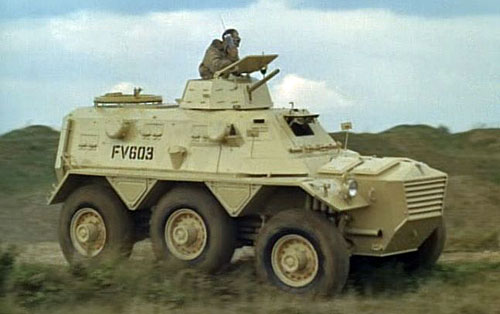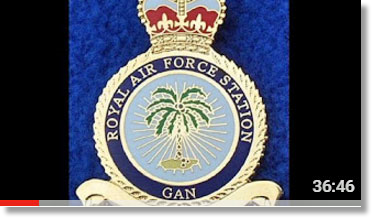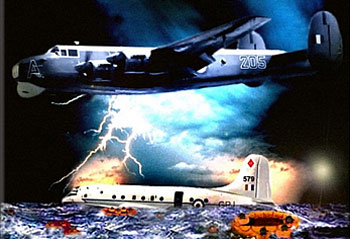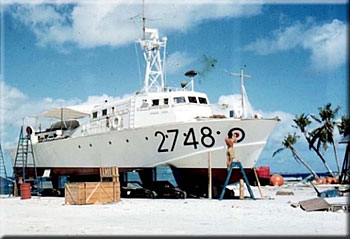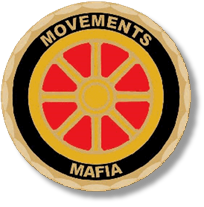
British troops flown to Estonia from RAF Brize Norton

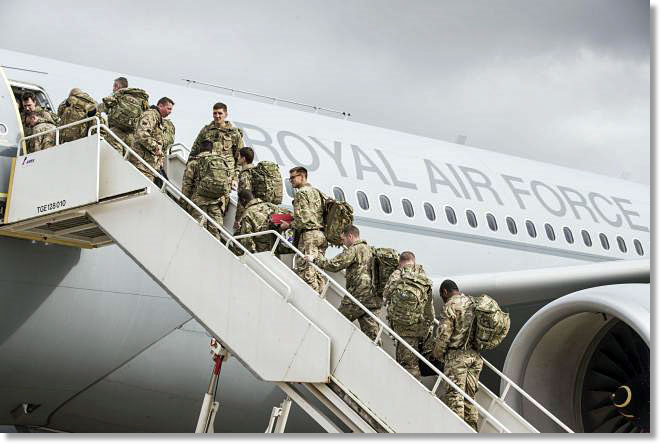
British toops have been flown from RAF Brize Norton to Estonia as part of a major NATO mission in the Baltic states to deter Russian aggression.
Around 120 soldiers from the 5th Battalion The Rifles landed at the Amari Airbase on Friday, 25 miles south-west of the capital Tallinn. They were welcomed by Estonia's Defence Minister, Margus Tsahkna, on their arrival from RAF Brize Norton.
Eight hundred British troops are due to be stationed in the country as part of one of the biggest deployments to Eastern Europe in decades. The first batch will set up a UK headquarters in the country before the rest arrive next month.
They will work alongside French and Danish forces to "provide a proportionate, defensive, and combat capable force to defend our NATO ally and deter any form of hostile activity against the Alliance", the Ministry of Defence said.
Britain is taking a leading role in the Estonia Battlegroup, while other nations are deploying troops to Latvia, Lithuania and Poland as part of NATO's Enhanced Forward Presence battalion.
Around 120 soldiers from the 5th Battalion The Rifles landed at the Amari Airbase on Friday, 25 miles south-west of the capital Tallinn. They were welcomed by Estonia's Defence Minister, Margus Tsahkna, on their arrival from RAF Brize Norton.
Eight hundred British troops are due to be stationed in the country as part of one of the biggest deployments to Eastern Europe in decades. The first batch will set up a UK headquarters in the country before the rest arrive next month.
They will work alongside French and Danish forces to "provide a proportionate, defensive, and combat capable force to defend our NATO ally and deter any form of hostile activity against the Alliance", the Ministry of Defence said.
Britain is taking a leading role in the Estonia Battlegroup, while other nations are deploying troops to Latvia, Lithuania and Poland as part of NATO's Enhanced Forward Presence battalion.
Around 300 UK vehicles have also left the UK this week by ferry headed for Estonia, including Challenger 2 tanks, Warrior infantry fighting vehicles, and AS90 self-propelled artillery pieces.
Britain and Estonia have a long history of defence co-operation. In November 1918 a Royal Navy squadron was deployed to the region to support the independence of the Baltic states.
Russia has described the latest positioning of NATO forces near its border as a threat, but Defence Secretary, Sir Michael Fallon, said: "In the face of an increasingly assertive Russia, NATO is stepping up its commitment to collective defence. "British troops will play a leading role in Estonia and support our US allies in Poland, as part of wider efforts to defend NATO. Our rising defence budget means we can support those deployments in the long-term and strengthen our commitment to European security."
Lieutenant Colonel Mark Wilson, Commanding Officer of 5th Battalion The Rifles, said: "The UK and Estonia have a long and proud history of serving together, including in Afghanistan, so it is an honour to lead 5 Rifles on this deployment as part of NATO's enhanced forward presence. My soldiers are looking forward to again be working, training and exercising alongside their Estonian counterparts."
Oxford Mail
Britain and Estonia have a long history of defence co-operation. In November 1918 a Royal Navy squadron was deployed to the region to support the independence of the Baltic states.
Russia has described the latest positioning of NATO forces near its border as a threat, but Defence Secretary, Sir Michael Fallon, said: "In the face of an increasingly assertive Russia, NATO is stepping up its commitment to collective defence. "British troops will play a leading role in Estonia and support our US allies in Poland, as part of wider efforts to defend NATO. Our rising defence budget means we can support those deployments in the long-term and strengthen our commitment to European security."
Lieutenant Colonel Mark Wilson, Commanding Officer of 5th Battalion The Rifles, said: "The UK and Estonia have a long and proud history of serving together, including in Afghanistan, so it is an honour to lead 5 Rifles on this deployment as part of NATO's enhanced forward presence. My soldiers are looking forward to again be working, training and exercising alongside their Estonian counterparts."
Oxford Mail
From: David Powell, Princes Risborough
Subject: Re: UKMAMS OBA OBB #022417
Hi Tony,
Thank you for the most recent Old Bods Brief, and another great memory stirring issue.
Subject: Re: UKMAMS OBA OBB #022417
Hi Tony,
Thank you for the most recent Old Bods Brief, and another great memory stirring issue.
So, the Army’s new troop carrying Dinky Toy won’t fit in the RAF’s new transport plane, the A400M Atlas? Nothing new there then! Back in the 1950s the Army initiated a new concept for protected troop carrying, in particular for tactical operations such as were being prosecuted in Malaya. The result was the FV603 Saracen six-wheeled armored personnel carrier built by Alvis. In parallel, the option of a military version of the Argosy (a Channel air bridge car carrier) was reinstated to replace the aging Valetta and Hastings fleets. The requirement was to accommodate 69 troops or 48 stretcher cases or 29,000 lb (13,000 kg) of freight so the Argosy could carry military equipment, in particular the super new Saracen. To this end, the rear doors were changed to 'clam shell' style with an integral loading ramp, and the floor was beefed up, seriously eating into the payload potential.
However, when it came to match the load carrier with its primary intended load, it was found that design changes to the Saracen and the RAF’s insistence on a main-spar, running through the top of the freight bay, which precluded the use of the Argosy as a Saracen transport. It wouldn’t fit! Mind you – super floor!
However, when it came to match the load carrier with its primary intended load, it was found that design changes to the Saracen and the RAF’s insistence on a main-spar, running through the top of the freight bay, which precluded the use of the Argosy as a Saracen transport. It wouldn’t fit! Mind you – super floor!
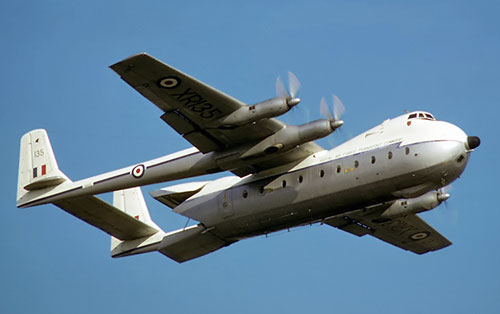
The initial Argosy deployments were in 1962 to 105 Squadron in the Middle East and 114 and 267 Squadrons at RAF Benson. The following year, 215 Squadron received its Argosies at RAF Changi, Singapore. I have some very happy memories of the Argosy, including a Victoria Cross & George Cross sweeper in 1966 with 215 Sqn which took in Gan, Cocos (Keeling) Islands, Australia (Edinburgh Field), New Zealand, French Caledonia, Admiralty Islands (where we refuelled by hand, the drums having been dropped off a passing freighter and floated ashore!), Philippines and back home to RAF Changi to hand over our precious cargo for on move by VC10 to London and tea with the Queen. The Argosy was also our bread and butter transport for Gulf MAMF’s regular runs in 1971 when I recall strange passengers, weapons, ammunition etc., from Bait al Falaj, Oman, into Salalah for very fast turnarounds. Some of the mortar wielding temporary residents were rather unfriendly, if they could get close enough. Now it is a popular tourist destination!
In the 'Memories of RAF Gutersloh' items, I was reminded of Op Motorman At the time I was the very junior logs plans part of the small ops planning team at Upavon which was to become HQ 46 Group on 1 September 1972. The complexity of the reinforcement airlift from Germany to Northern Ireland was compounded by several significant factors: the secrecy surrounding the operation, the challenge of fitting the airlift around a very public RAF air show (at Gutersloh or was it Wildenrath?) on the Saturday, and the very close involvement of No 10, especially because the top team at MoD had promised the Prime Minister, Ted Heath, that the reinforcement operation would start on the Friday. I seem to recall we were only given the task of planning and laying on the airlift on the Tuesday, and we met the last challenge by getting the one route activation aircraft with the necessary slip crews etc. airborne at 23.55 on the Friday night. “Yes, please tell the Prime Minister the operation is underway!”
Finally - Jim Shearer. He was our supply and movements instructor during my time at Cranwell, and the best! He was also the reason that I wanted to get involved with Movements. So now long suffering colleagues know who to blame!
Stay safe, regards to all
David Powell
F Team RAF Abingdon 1967-69
Finally - Jim Shearer. He was our supply and movements instructor during my time at Cranwell, and the best! He was also the reason that I wanted to get involved with Movements. So now long suffering colleagues know who to blame!
Stay safe, regards to all
David Powell
F Team RAF Abingdon 1967-69
RAF to ban women from wearing skirts on parade so transgender personnel don't feel excluded
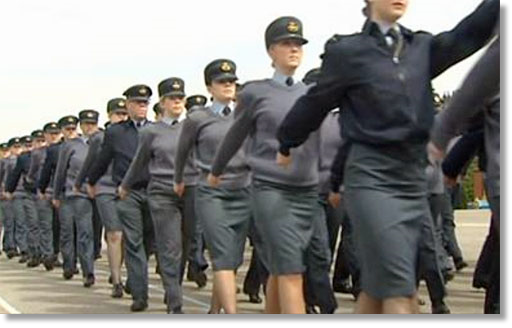
The RAF has banned servicewomen from wearing skirts on parade so that transgender personnel don't feel excluded.
The MoD has taken the stance on uniform after an increase in trans recruits and it hopes that the move will show it is a 'modern' and 'inclusive' force. However, the decision has been slammed by servicewomen as political correctness gone 'mad'.
Under the new plans, women will be ordered to wear trousers on parades, on barracks and during public events.
It is believed the ban was discussed at a meeting of RAF top brass, but the ban has yet to be enforced. An RAF source said: 'It’s about including people and encouraging diversity.'
One furious servicewoman fumed: 'Everyone's livid. We've been wearing skirts since World War II. It feels like political correctness. The world's going mad.'
The MoD has taken the stance on uniform after an increase in trans recruits and it hopes that the move will show it is a 'modern' and 'inclusive' force. However, the decision has been slammed by servicewomen as political correctness gone 'mad'.
Under the new plans, women will be ordered to wear trousers on parades, on barracks and during public events.
It is believed the ban was discussed at a meeting of RAF top brass, but the ban has yet to be enforced. An RAF source said: 'It’s about including people and encouraging diversity.'
One furious servicewoman fumed: 'Everyone's livid. We've been wearing skirts since World War II. It feels like political correctness. The world's going mad.'
While Colonel Richard Kemp, former commander of British forces in Afghanistan, also slammed the ban. He told the Sun: 'There are obviously too many people in the RAF with too little to do if they have time to agonise over whether or not women should wear skirts in ceremonial uniform.'
Mail Online
Mail Online
From: Ronald Meredith, Spalding, Lincs
Subject: Re: UKMAMS OBA OBB #022417
Thanks for yet another wonderful Newsletter Tony, your efforts on behalf of us all are highly commended.
Re latest edition, happens that I was at RNZAF Ohakea in October 59 as part of 619 Sqn from Scampton. 4 Vulcans, with us support troops travelling by Britannia. We were there to celebrate the opening of Rongotai, Wellington International Airport, together with ac from the RAAF, USAF and USN, plus a Beverly from Changi to give us local tactical support. The RNZAF could not have been kinder or more hospitable.
I flew down with ground crew and assorted kit on the morning of the airshow in the Beverley, but unfortunately, the weather clamped after arrival at Rongatai; the airshow was delayed for 24 hrs. Next day, weather marginal but events proceeded. The first fly past by an RNZAF Sunderland resulted in it scraping its keel along the runway and having to beach back at its Phenuapi (Auckland) base.
Subject: Re: UKMAMS OBA OBB #022417
Thanks for yet another wonderful Newsletter Tony, your efforts on behalf of us all are highly commended.
Re latest edition, happens that I was at RNZAF Ohakea in October 59 as part of 619 Sqn from Scampton. 4 Vulcans, with us support troops travelling by Britannia. We were there to celebrate the opening of Rongotai, Wellington International Airport, together with ac from the RAAF, USAF and USN, plus a Beverly from Changi to give us local tactical support. The RNZAF could not have been kinder or more hospitable.
I flew down with ground crew and assorted kit on the morning of the airshow in the Beverley, but unfortunately, the weather clamped after arrival at Rongatai; the airshow was delayed for 24 hrs. Next day, weather marginal but events proceeded. The first fly past by an RNZAF Sunderland resulted in it scraping its keel along the runway and having to beach back at its Phenuapi (Auckland) base.
Although we attempted to clear Vulcan debris, now FOD, off the main runway, the Rogatai authorities would not allow us to depart in the Beverly via the main runway.
However, our ever tactical captain, informed the tower that our return with critical ground equipment and personnel was essential, would they exceptionally authorise our take off from the parallel taxi way. Agreed and probably provided the best display of the show as we took off and winged it back to Ohakea.
However, our ever tactical captain, informed the tower that our return with critical ground equipment and personnel was essential, would they exceptionally authorise our take off from the parallel taxi way. Agreed and probably provided the best display of the show as we took off and winged it back to Ohakea.
Vulcan XH 498 was to be the last performer, with a landing at the new airfield. Unfortunately after one trial touch and go, and and abortive attempted landing, on the next attempt, the wind shear resulted in the port gear being smashed on the threshold and the port wing tip dragging along the ground; full power and the ac climbed away to make a landing back at Ohakea, where the broken port gear resulted in it swinging off the runway and coming to a safe stop in the bundu. Happily, not one crew member injured.
The final outcome was that I was left behind with the Crew Chief to arrange ac recovery and hand over to an AVRO repair team. Home on 22 Dec via RNZAF Bristol "Frightener" Ohakea to Auckland, RNZAF Hastings to Changi and Comet 4 Changi to Lyneham.
A further bonus was the following year in April, I was recalled from a detachment to our Forward Operating Base at RNAS Lossiemouth to Scampton to be given 7 days to organise a recovery trip. Initially a Britannia, then 3 days before departure, this changed to a Hastings, so delete assorted techies and kit to remain within critical payload leg and we were off; 8 days and 76 odd flying hours later, we were back at Ohakea and in due course, XH 498 returned safely to Scampton.
A most interesting part of my tour. I was not in "Stores", I was full time with 617 Sqn and throughout the rest of my RAF time, had only ever 1 tour in a real stores environment and I was delighted to be otherwise occupied.
Ron Meredith
A further bonus was the following year in April, I was recalled from a detachment to our Forward Operating Base at RNAS Lossiemouth to Scampton to be given 7 days to organise a recovery trip. Initially a Britannia, then 3 days before departure, this changed to a Hastings, so delete assorted techies and kit to remain within critical payload leg and we were off; 8 days and 76 odd flying hours later, we were back at Ohakea and in due course, XH 498 returned safely to Scampton.
A most interesting part of my tour. I was not in "Stores", I was full time with 617 Sqn and throughout the rest of my RAF time, had only ever 1 tour in a real stores environment and I was delighted to be otherwise occupied.
Ron Meredith
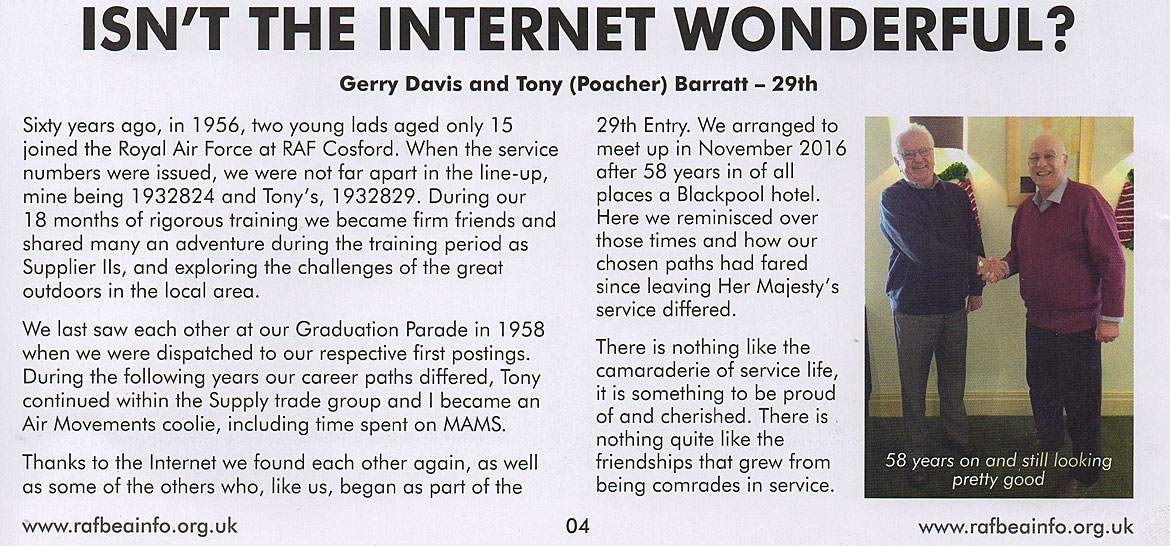
Vimy Flight aircraft arrive in France
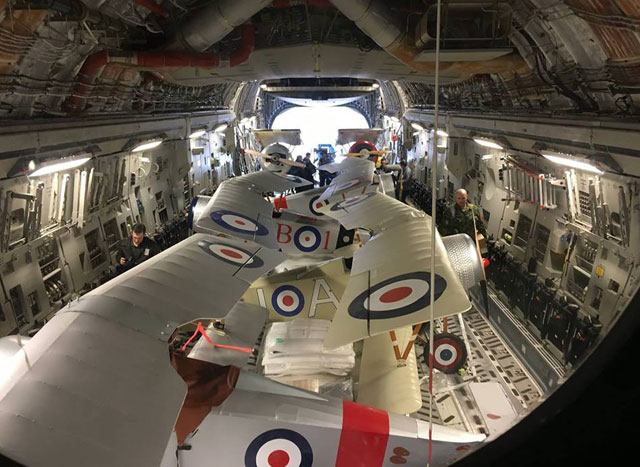
How many World War I replica aircraft can you fit into a CC-177 Globemaster?
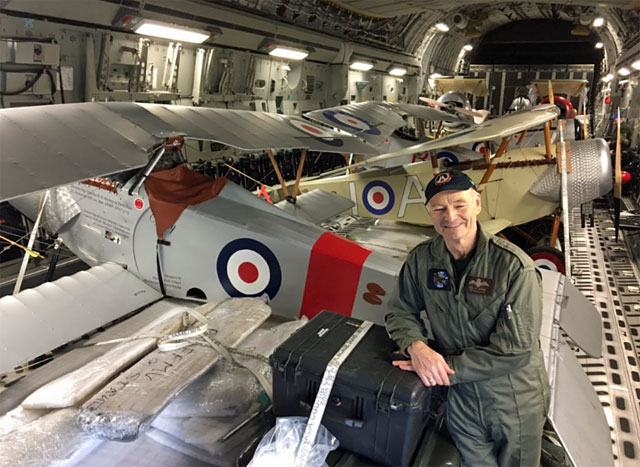
Allan Snowie, team lead for Vimy Flight, stands with replica aircraft
inside a CC-177 Globemaster from 429 Transport Squadron
inside a CC-177 Globemaster from 429 Transport Squadron
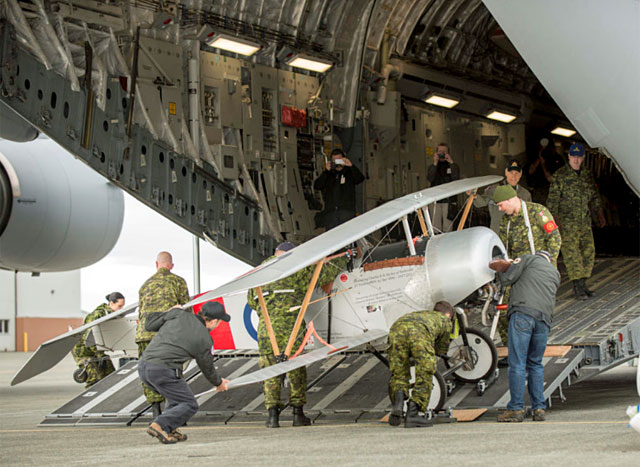
A Nieuport XI replica is loaded into a CC-177 Globemaster at
19 Wing Comox, B.C., before being transported to France
19 Wing Comox, B.C., before being transported to France
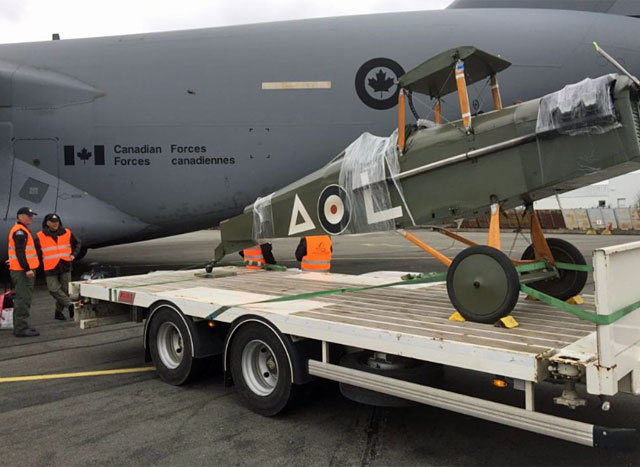
A Royal Aircraft Factory S.E.5 replica, with its wings detached,
rests on a platform next to the CC-177 Globemaster
rests on a platform next to the CC-177 Globemaster
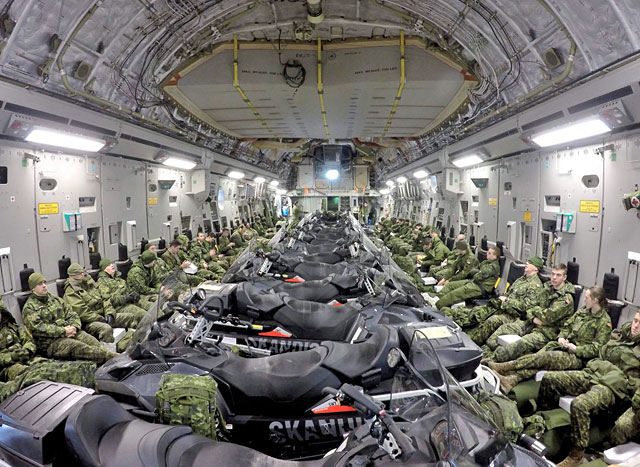
How many snowmobiles can you get in a CC-177 Globemaster?
[Whoops - wrong article!]
[Whoops - wrong article!]
Seven First World War-era replica aircraft have arrived in France ahead of a ceremony that will mark the 100th anniversary of the Battle of Vimy Ridge.
The four Nieuport XI replica Scout aircraft, two Sopwith Pup replica biplanes and one replica Royal Aircraft Factory S.E.5 biplane, are part of Vimy Flight, a group of builders and former Canadian military pilots and will form part of Canada’s contribution to the Vimy centennial on April 9.
“I’m anxious about the weather,” said Allan Snowie, a former Royal Canadian Navy pilot and team lead for Vimy Flight. “I’m excited about the flying. Bad weather is the only thing that would keep the Nieuport and S.E.5 replicas from participating in the ceremony."
The aircraft are slated to fly over the Vimy memorial just as members of the British royal family arrive for a commemoration that is also expected to include Canadian Prime Minister Justin Trudeau and French President Francois Hollande.
While the two Sopwith Pup replicas were also originally slated to fly over the memorial, they will now be part of a static display.
The four Nieuport XI replica Scout aircraft, two Sopwith Pup replica biplanes and one replica Royal Aircraft Factory S.E.5 biplane, are part of Vimy Flight, a group of builders and former Canadian military pilots and will form part of Canada’s contribution to the Vimy centennial on April 9.
“I’m anxious about the weather,” said Allan Snowie, a former Royal Canadian Navy pilot and team lead for Vimy Flight. “I’m excited about the flying. Bad weather is the only thing that would keep the Nieuport and S.E.5 replicas from participating in the ceremony."
The aircraft are slated to fly over the Vimy memorial just as members of the British royal family arrive for a commemoration that is also expected to include Canadian Prime Minister Justin Trudeau and French President Francois Hollande.
While the two Sopwith Pup replicas were also originally slated to fly over the memorial, they will now be part of a static display.
“We had made a last-minute decision two months ago to change the engine on the two Sopwith Pups, and that put us behind the eight ball in getting them ready for flight,” said Snowie. “It was one of these things where it was gratifying to see how the Canadian aviation community sort of closed ranks around us … Unfortunately, we didn’t get the second Sopwith Pup test-flown yet.”
All seven aircraft were packed into the belly of a 429 Transport Squadron CC-177 Globemaster III and flown from 19 Wing Comox, B.C., to Gander, Newfoundland before carrying on to Lille, France. The Nieuports were packed with their wings on, but the Sopwith Pups and S.E.5 were packed with wings off – the only major disassembly required for the journey. A post on the Vimy Flight Facebook page compared the packing process to the video game Tetris. “The air force loadmasters have done a great job,” said Snowie. “I think they took it as a personal challenge.”
All seven aircraft were packed into the belly of a 429 Transport Squadron CC-177 Globemaster III and flown from 19 Wing Comox, B.C., to Gander, Newfoundland before carrying on to Lille, France. The Nieuports were packed with their wings on, but the Sopwith Pups and S.E.5 were packed with wings off – the only major disassembly required for the journey. A post on the Vimy Flight Facebook page compared the packing process to the video game Tetris. “The air force loadmasters have done a great job,” said Snowie. “I think they took it as a personal challenge.”
From: John Guy, Northampton
Subject: The Last Newsletter - WO in a Trilby!
Hello Tony,
Congratulations on publishing what I consider to be the best ever informative read that is the February newsletter. The fact that I did a tour at Gutersloh has made it even more interesting.
Geordie Stanger was my passenger sergeant at Gutersloh. He did ask me if it was okay to send in the trilby item but the crafty devil never mentioned anything about a photograph! I have never forgotten the incident, and it has given my wife and I another good laugh. That picture does not show me in uniform, which I was, including a service raincoat and the trilby. When I saluted the officer he just gave me a wry smile and continued on his way.
Geordie forgot to mention that the squadron would also elect a "Wally of the Month” of which I became one!
I hope that you will be able to continue the good work, it really is a good read.
Regards
John
Subject: The Last Newsletter - WO in a Trilby!
Hello Tony,
Congratulations on publishing what I consider to be the best ever informative read that is the February newsletter. The fact that I did a tour at Gutersloh has made it even more interesting.
Geordie Stanger was my passenger sergeant at Gutersloh. He did ask me if it was okay to send in the trilby item but the crafty devil never mentioned anything about a photograph! I have never forgotten the incident, and it has given my wife and I another good laugh. That picture does not show me in uniform, which I was, including a service raincoat and the trilby. When I saluted the officer he just gave me a wry smile and continued on his way.
Geordie forgot to mention that the squadron would also elect a "Wally of the Month” of which I became one!
I hope that you will be able to continue the good work, it really is a good read.
Regards
John
From: Dave Neylan, Amberley, QLD
Subject: Re: #3 Movements Reunion
G'Day Tony,
In 2011 the first Movements Mafia reunion was held with over 120 serving and ex-serving members in attendance. There has been a lot of interest over the last four years to conduct a similar event, so the time has come again to hold another reunion. The details are as follows:
WHEN: Saturday 17 June 2017
WHERE: Ipswich Turf Club on Ipswich Cup Race Day
WHAT: A Private Grandstand Marquee
These marquees are on the grandstand side of the track and have a trackside view of the races. Marquee tickets are $166 each (includes ticket postage) and covers:
Subject: Re: #3 Movements Reunion
G'Day Tony,
In 2011 the first Movements Mafia reunion was held with over 120 serving and ex-serving members in attendance. There has been a lot of interest over the last four years to conduct a similar event, so the time has come again to hold another reunion. The details are as follows:
WHEN: Saturday 17 June 2017
WHERE: Ipswich Turf Club on Ipswich Cup Race Day
WHAT: A Private Grandstand Marquee
These marquees are on the grandstand side of the track and have a trackside view of the races. Marquee tickets are $166 each (includes ticket postage) and covers:
•
Entry to the track.
•
Access to the after party and live band.
•
6 hour beverage package from 11am to 5pm.
Beer: XXXX Gold, Hahn Super Dry 3.5, Hahn Super Dry, XXXX Summer Bright range, Heineken, James Squire 150 Lashes, 5 Seeds Crisp Apple Cider
Wine: Sirromet selections of Red Wine, White Wine and Sparkling.
Spirits: Premix RTD drinks of Bundaberg Rum & Cola, Johnnie Walker Scotch & Cola, Bulleit Bourbon & Cola, Lazy Bear Dry & Lime, and UDL vodka cans in 4 flavours.
Non-alcoholic: A variety of Schweppes soft drinks and water.
3 hours standard hot and cold finger food package: wraps, sushi, prawn cones, cocktail spring rolls , mini chicken dimsums, King Island beef pies, cocktail sausage rolls.
Wine: Sirromet selections of Red Wine, White Wine and Sparkling.
Spirits: Premix RTD drinks of Bundaberg Rum & Cola, Johnnie Walker Scotch & Cola, Bulleit Bourbon & Cola, Lazy Bear Dry & Lime, and UDL vodka cans in 4 flavours.
Non-alcoholic: A variety of Schweppes soft drinks and water.
3 hours standard hot and cold finger food package: wraps, sushi, prawn cones, cocktail spring rolls , mini chicken dimsums, King Island beef pies, cocktail sausage rolls.
A challenge coin has been made for the event which will cost $11 each. Payment for the coin must be received by the 10th of April to ensure they arrive in time for the Ipswich Cup on the 17th of June. To cover the coin and a progression payment for the marquee we will require a minimum $50 deposit by no later than the 10th of April 2017 (this will be non-refundable). The final payment for the reunion is due by the 29th of May 2017. Once the final payment has been made we will arrange to have the the tickets sent out to you. Bank account details are as follows;
Bank: Defence Bank
BSB: 803-205
Account Name: David Neylan
Account Number: 20405946
Bank: Defence Bank
BSB: 803-205
Account Name: David Neylan
Account Number: 20405946
Payment Reference: YOUR NAME (Please provide your full name in order to determine who has made a payment). Once you have transferred the money please send your postal address and details to the following email account: movementsmafia@mail.com
This reunion is open to everyone that is a Mover, was a Mover, wants to be a Mover, or even once met a Mover, partners are also most welcome.
Please direct all enquirers to movementsmafia@mail.com or call the following Members if you have any issues or concerns:
Dave Neylan 0438 641 997 / Mick Stephenson 0431 926 534
We are looking forward to seeing you all there.
Cheers, Dave Neylan
This reunion is open to everyone that is a Mover, was a Mover, wants to be a Mover, or even once met a Mover, partners are also most welcome.
Please direct all enquirers to movementsmafia@mail.com or call the following Members if you have any issues or concerns:
Dave Neylan 0438 641 997 / Mick Stephenson 0431 926 534
We are looking forward to seeing you all there.
Cheers, Dave Neylan
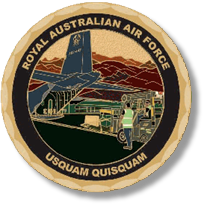
Memories of RAF Gan
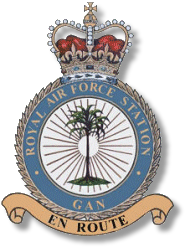
Royal Air Force Station Gan, commonly known as RAF Gan, was a former Royal Air Force station on Gan Island, the southern-most island of Addu Atoll which is part of the larger groups of islands which form the Maldives, in the middle of the Indian Ocean. The airfield is now Gan International Airport.
The area was originally established as a military base for the Royal Navy in 1941. Royal Navy engineers began constructing airstrips on Gan island in August 1941 for the Fleet Air Arm.
During World War II, in 1942 the RAF had its bases in the Islands of Addu Atoll, Maldives. The RAF first had a presence on Hithadoo in 1942 when a detachment of RAF personnel were sent from RAF China Bay in Ceylon to service and turn around the RAF Short Sunderland and PBY Catalina flying boats that were flying regularly into the Addu Atoll lagoon. At the end of the war, all military installations were either removed or abandoned.
The area was originally established as a military base for the Royal Navy in 1941. Royal Navy engineers began constructing airstrips on Gan island in August 1941 for the Fleet Air Arm.
During World War II, in 1942 the RAF had its bases in the Islands of Addu Atoll, Maldives. The RAF first had a presence on Hithadoo in 1942 when a detachment of RAF personnel were sent from RAF China Bay in Ceylon to service and turn around the RAF Short Sunderland and PBY Catalina flying boats that were flying regularly into the Addu Atoll lagoon. At the end of the war, all military installations were either removed or abandoned.
In 1957 the Royal Air Force needed a staging post between its bases in the Middle East and Far East and the location was virtually limited to Gan, and so Royal Air Force Station Gan became established in the late 1950s as a stopover on the reinforcement route to the Far East Air Force based in Singapore. The previous reinforcement route had passed through countries that had formerly been British territory but were now independent, and sometimes hostile nations. RAF Mauripur, to the west of Karachi, by then a Pakistan Air Force station, had RAF personnel attached for staging airfield purposes up until 1956, when the staging role between the Middle East and Far East fell to RAF Gan.
It was extensively used as a staging post by bombers, fighters and transports on their way to Singapore and other destinations in east Asia during the late 1950s and the 1960s. Other foreign military forces, like the US, occasionally used the facilities. However, as the 1970s dawned, the United Kingdom was withdrawing from its commitments east of the Suez. By the end of 1971 the RAF Far East Air Force was disbanded and the major rationale for Gan was gone. Traffic was now much less frequent but the base still remained open for a few more years. By 1975 British military aircraft using the base were an extreme rarity. RAF Gan was thus closed and on 1 April 1976 the island was handed back to the Maldivian Government. At the same time as RAF use of the airfield ceased, the RAF gained access to the then newly built US airfield two hundred miles to the south of Gan on the British island of Diego Garcia.
It was extensively used as a staging post by bombers, fighters and transports on their way to Singapore and other destinations in east Asia during the late 1950s and the 1960s. Other foreign military forces, like the US, occasionally used the facilities. However, as the 1970s dawned, the United Kingdom was withdrawing from its commitments east of the Suez. By the end of 1971 the RAF Far East Air Force was disbanded and the major rationale for Gan was gone. Traffic was now much less frequent but the base still remained open for a few more years. By 1975 British military aircraft using the base were an extreme rarity. RAF Gan was thus closed and on 1 April 1976 the island was handed back to the Maldivian Government. At the same time as RAF use of the airfield ceased, the RAF gained access to the then newly built US airfield two hundred miles to the south of Gan on the British island of Diego Garcia.
RAF Gan ~ The Early Years ~ by the late Squadron Leader Jack Riley
By the time I found myself on the island again in September, 1959, the whole atmosphere had changed. Gone was the tropical idyll to be replaced by a working base. Now there was a CO with a jeep. Pakistani labourers had been brought in as a work force and were able to buy television sets at their canteen, presumably to take home at the end of their stint. Some island workers still remained and I believe that they would only accept payment in coin with the King's head on it and that the Royal Mint ran off a special minting. Later, when the villagers were re-housed further up the chain and their old village was bulldozed, much of the coin was unearthed.
There was still a destroyer off the island but whether it was the same one I can't recall. The new Airmen's Mess was well advanced and work elsewhere on the island moving apace. I shall be forever grateful that I saw it "as it was".
Jack Riley, September, 2001
There was still a destroyer off the island but whether it was the same one I can't recall. The new Airmen's Mess was well advanced and work elsewhere on the island moving apace. I shall be forever grateful that I saw it "as it was".
Jack Riley, September, 2001
There was another occasion when I visited Gan, but it was no longer an RAF base. It was in 2006 when I was a member of the British Red Cross Society (BRCS) Logistics Emergency Response Unit (ERU). My team was based in Sri Lanka after the Tsunami disaster of 2005. I was sent to The Maldives to help the truly International rescue effort and re-building (recovery) programme. The BRCS was allocated three Atolls, one of which included Gan.
Cheers, David
Cheers, David
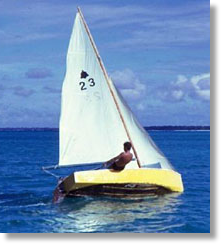
From: Andrew Spinks, Dubai
Subject: Memories of RAF Gan
Sadly, I only spent an hour on the ground in Gan as we passed through on the VC10 OCU trainer. I got the Masirah stint while that man about town and suave operator Don Hunter got the Gan stint! Having spent several thousand pounds since to enjoy less than a week in the Maldives, it will be interesting to read whether those posted to Gan appreciated the potential value of where they lived for 9 months! I bet a few of them wish they had taken a stake in RAF Gan when it closed.
Regards, Andy
Subject: Memories of RAF Gan
Sadly, I only spent an hour on the ground in Gan as we passed through on the VC10 OCU trainer. I got the Masirah stint while that man about town and suave operator Don Hunter got the Gan stint! Having spent several thousand pounds since to enjoy less than a week in the Maldives, it will be interesting to read whether those posted to Gan appreciated the potential value of where they lived for 9 months! I bet a few of them wish they had taken a stake in RAF Gan when it closed.
Regards, Andy
From: Bryan Morgan, Abingdon
Subject: Fond memories of Gan!
Tony,
Subject: Fond memories of Gan!
Tony,
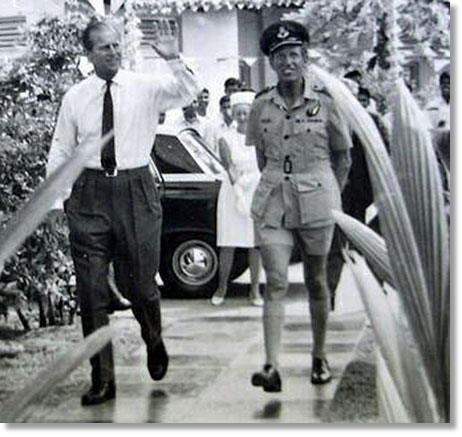
In 1970, as S Mov O and Officer i/c the Corporal's Club, I was tasked with arranging entertainment for the Duke of Edinburgh as he flag-stopped en-route, on a Sunday afternoon, from W Australia to the UK in a 216 Sqn Comet IV.
Enquiries revealed that his favourite tipple was a G & T and, as all the tonic water was locally produced from desalinated and tasted bloody awful, I arranged for 24 bottles of Schweppes to be flown from Lyneham. These were kept under lock and key until the due day.
On arrival at the Corporals Club, where eight disgruntled groups of all ranks had been assembled to meet him, I invited HRH to partake, confident in the fact that the bottles of tonic were perfectly chilled with a choice of lemon or lime. My ego took a knock when the Duke replied that he "could murder a pint". HRH then proceeded to talk to each group in turn leaving each one in stitches. When he came to leave he turned and thanked all those present and said how sorry he was that everyone would have to give up a certain something for Christmas.
Afterwards, with disgruntlement a thing of the past, all agreed that it had been one ofthe best Sunday afternoons they had spent on the island - all toasting his health with, needless to say, a very tasty drink with a choice of lemon or lime!
Bryan Morgan
Enquiries revealed that his favourite tipple was a G & T and, as all the tonic water was locally produced from desalinated and tasted bloody awful, I arranged for 24 bottles of Schweppes to be flown from Lyneham. These were kept under lock and key until the due day.
On arrival at the Corporals Club, where eight disgruntled groups of all ranks had been assembled to meet him, I invited HRH to partake, confident in the fact that the bottles of tonic were perfectly chilled with a choice of lemon or lime. My ego took a knock when the Duke replied that he "could murder a pint". HRH then proceeded to talk to each group in turn leaving each one in stitches. When he came to leave he turned and thanked all those present and said how sorry he was that everyone would have to give up a certain something for Christmas.
Afterwards, with disgruntlement a thing of the past, all agreed that it had been one ofthe best Sunday afternoons they had spent on the island - all toasting his health with, needless to say, a very tasty drink with a choice of lemon or lime!
Bryan Morgan
From: David Powell, Princes Risborough
Subject: Memories of RAF Gan – Sort Of
Hi Tony,
I never served at Gan but bounced through on several occasions, including a few night stops during my first tour of duty at RAF Changi, Singapore (well you have to expect your share of the rough jobs), in the mid-60s. And, Gan was very much part of lives, especially for the Changi Movements Squadron as it was the first and last stepping stone from and to Changi with the excitement of the (twice weekly?) evening departures of the returning Comet 4 schedules to UK.
Although posted to the Supply outfit at Changi, there were times when I would find myself down at Movements. It was on one of these occasions when the departing Comet had just lifted off into the night and Fg Off Joan Haines, the duty movements passenger officer (most shifts had Flt Lt DAMO and a supporting very junior officer), came back into the Terminal with a very puzzled expression on her face saying that she was sure that there was something not quite right about that departure, but she couldn’t pin it down. Then after a few minutes head scratching she came out with, "I know what it was – there was a sailor in uniform, with a parrot on his shoulder!”
Needless to say, signals were dispatched to RAF Gan advising that there was a suspected green stowaway on board, please apprehend!
Happy days - David Powell
Subject: Memories of RAF Gan – Sort Of
Hi Tony,
I never served at Gan but bounced through on several occasions, including a few night stops during my first tour of duty at RAF Changi, Singapore (well you have to expect your share of the rough jobs), in the mid-60s. And, Gan was very much part of lives, especially for the Changi Movements Squadron as it was the first and last stepping stone from and to Changi with the excitement of the (twice weekly?) evening departures of the returning Comet 4 schedules to UK.
Although posted to the Supply outfit at Changi, there were times when I would find myself down at Movements. It was on one of these occasions when the departing Comet had just lifted off into the night and Fg Off Joan Haines, the duty movements passenger officer (most shifts had Flt Lt DAMO and a supporting very junior officer), came back into the Terminal with a very puzzled expression on her face saying that she was sure that there was something not quite right about that departure, but she couldn’t pin it down. Then after a few minutes head scratching she came out with, "I know what it was – there was a sailor in uniform, with a parrot on his shoulder!”
Needless to say, signals were dispatched to RAF Gan advising that there was a suspected green stowaway on board, please apprehend!
Happy days - David Powell
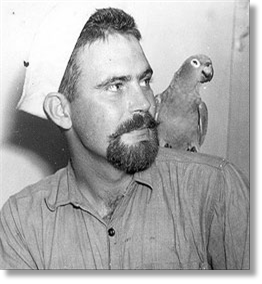
From: Len Bowen, Chisholm, ACT
Subject: Memories of RAF Gan
G'day Tony,
I was lucky enough to miss Gan on most of my transits to and from FEAF, but I do remember just one involuntary night stop when our Comet had some electronic problem en-route from Singapore to UK in 1966*.
As transit PAX we were taken to our respective Messes for a meal, and from there I made my way to the beach, clutching a 21/- bottle of Drambuie (don't ask). I had heard that after a few months on Gan most people went troppo, so I wasn't too surprised to see at least a dozen blokes stretched out on the sand gazing at the night sky. I sat myself down to enjoy the cool of the evening and listen to the 'conversation'.
Subject: Memories of RAF Gan
G'day Tony,
I was lucky enough to miss Gan on most of my transits to and from FEAF, but I do remember just one involuntary night stop when our Comet had some electronic problem en-route from Singapore to UK in 1966*.
As transit PAX we were taken to our respective Messes for a meal, and from there I made my way to the beach, clutching a 21/- bottle of Drambuie (don't ask). I had heard that after a few months on Gan most people went troppo, so I wasn't too surprised to see at least a dozen blokes stretched out on the sand gazing at the night sky. I sat myself down to enjoy the cool of the evening and listen to the 'conversation'.

"There's Number 7". "That's the Fourth". "Number Ten is on time". OK. these blokes really are troppo; they're waiting for a bus? Finally I plucked up enough courage to ask one of my beach-lounging neighbours. "When's the next one due?" "Oh, Telstar is along in about ten minutes and after that Sputnik 5 will go over at 22:03".
Yes, they were all satellite watching. In the absence of TV, the film in the Mess or whatever, a group just lay back on the beach every evening, watched the sky and clocked the passing satellites! Well, I guess it was one way to pass 12 months unaccompanied!
Cheers, Len
*Was en-route to UK to do the CONDEC Driver/Instructor /Examiner course at Abingdon. courtesy of a very understanding CO FEAF MAMS who gave me a two week course in UK, followed by two weeks leave with my folks after my year at Labuan.
Yes, they were all satellite watching. In the absence of TV, the film in the Mess or whatever, a group just lay back on the beach every evening, watched the sky and clocked the passing satellites! Well, I guess it was one way to pass 12 months unaccompanied!
Cheers, Len
*Was en-route to UK to do the CONDEC Driver/Instructor /Examiner course at Abingdon. courtesy of a very understanding CO FEAF MAMS who gave me a two week course in UK, followed by two weeks leave with my folks after my year at Labuan.
From: John Leek, La Ronde 79380
Subject: Memories of RAF Gan
Hi Tony,
Never posted to Gan but passed through twice in 1963 and again (with my family) in 1975 - this was in the early hours of the morning and we all remember the fruit bats that had roundels painted under their wings!
Regards, John
Subject: Memories of RAF Gan
Hi Tony,
Never posted to Gan but passed through twice in 1963 and again (with my family) in 1975 - this was in the early hours of the morning and we all remember the fruit bats that had roundels painted under their wings!
Regards, John
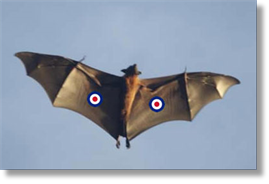
The Lonely Men of Coral Command
Originally filmed by Anglia Television in 1970
Originally filmed by Anglia Television in 1970
Click on the image above to view the movie
Documentary film on the RAF station on Gan, one of the Maldive Islands in the Indian Ocean. RAF Gan was used as a refuelling stop for aircraft flying between the Far East and the Persian Gulf and Mediterranean; the narrator explains how RAF personnel were stationed on the island for a year's posting, were not permitted to visit other islands in the Maldives and received one break midway through the tour for a visit to the UK or Singapore.The chaplain, commanding officer and the island's only female resident, a member of the Women's Royal Voluntary Service, all talk about life on the island and the psychological problems caused by the isolation and confinement.
Outlets include work, exercise and sport, including swimming, football and golf. A smaller nearby island, Hithadoo, used to base a transmitting station, is mentioned and the station's responsibilities for search and rescue are covered. The narrator also discusses the island's geography and wildlife.
Outlets include work, exercise and sport, including swimming, football and golf. A smaller nearby island, Hithadoo, used to base a transmitting station, is mentioned and the station's responsibilities for search and rescue are covered. The narrator also discusses the island's geography and wildlife.
From: Tony Street, Buffalo, NY
Subject: Gan
Subject: Gan
My short, but memorable visit to RAF Gan*
(*To the best of my recollection and with some names changed to protect the guilty)
(*To the best of my recollection and with some names changed to protect the guilty)
During April, 1960, I was on 437(T) Sqn, RCAF Stn. Trenton, Ontario flying as a loadmaster on the Yukon (CC106) aircraft. On this particular trip, we were on a 12 day Round-The-World training mission, where transited Gan on the 14th for a RON and fuel stop. We were to depart at 1500 the next day.
On such a trip, we had three crews aboard, one instructor crew and two crews in transition training. For the purpose of this tale, we will forget them and turn our attention to the Loadies. I was the instructor and my two students, and long-time friends, were “Bob” & “Weave,” converting from lesser airframes.
We arrived about 1700 and were shown to the sparse transient quarters where we promptly changed into mufti and enquired of our RAF neighbor, “Where’s the bar?” Needing no further reason than the question, he said, “Follow me,” and of we went. It was a very nice bar.
So nice, in fact that we missed the mess hours for dinner. Around 2100 our RAF newfound best friends forever (BFF in today’s textspeak), suggested we BBQ something or other so we set about doing this on the beach. The food was excellent and the beer flowed freely and was cold. About 0300, I got Bob & Weave to one side and suggested that Weave pack it in as he was on the working crew later in the day and that pointed out that Bob and I would be pax on the leg and liked our coffee “NATO Standard.” Weave trundled off and Bob and I stayed on.
On such a trip, we had three crews aboard, one instructor crew and two crews in transition training. For the purpose of this tale, we will forget them and turn our attention to the Loadies. I was the instructor and my two students, and long-time friends, were “Bob” & “Weave,” converting from lesser airframes.
We arrived about 1700 and were shown to the sparse transient quarters where we promptly changed into mufti and enquired of our RAF neighbor, “Where’s the bar?” Needing no further reason than the question, he said, “Follow me,” and of we went. It was a very nice bar.
So nice, in fact that we missed the mess hours for dinner. Around 2100 our RAF newfound best friends forever (BFF in today’s textspeak), suggested we BBQ something or other so we set about doing this on the beach. The food was excellent and the beer flowed freely and was cold. About 0300, I got Bob & Weave to one side and suggested that Weave pack it in as he was on the working crew later in the day and that pointed out that Bob and I would be pax on the leg and liked our coffee “NATO Standard.” Weave trundled off and Bob and I stayed on.
An hour or so later, the sun started its rise and we saw the islanders who worked on Gan arrive in their canoes and the gang decided to pack it in and get some sleep. But, the best was yet to come. Custom had it that the RAF chappies took a dip in the ocean before bed. As they got ready, they invited Bob and me to join them. We were told that because of the coral on the beach we must wear flip flops to traverse it. The idea was that a guy would get past the coral and toss us his flip flops where we would don them and follow. This was a good plan and worked well for me. Bob was another story.
In his younger days, Bob was an accomplished athlete, able to leap tall….well you get the idea. Since those days, he had put on a few pounds and a bit of girth. In this case, his added girth was to prove his downfall.
Seeing all the mamby pamby RAF troops and their girly flip flop routine caused Bob to recall his athletic days and he leapt to his unsteady feet and roared, “Hold my beer and watch this!” I did. I saw him draw himself to his full 6’3’’ height, throw his shoulders back and raced toward the beach. As he hit the line of coral he threw himself skyward and assumed the position of an Olympic diver. He shot, screaming, across the band of coral, and almost cleared it. One sixty fourth of an inch less girth and our story would end here.
Not realizing his condition he surfaced and roared, “That’s how it’s done, Mates, no flip flops for me!” Then one of the mates pointed to Bob’s chest and say, Wots that lot, then?” Bob looked at himself and saw blood running down his body from a thousand tiny cuts. It looked bad, If not serious.
In his younger days, Bob was an accomplished athlete, able to leap tall….well you get the idea. Since those days, he had put on a few pounds and a bit of girth. In this case, his added girth was to prove his downfall.
Seeing all the mamby pamby RAF troops and their girly flip flop routine caused Bob to recall his athletic days and he leapt to his unsteady feet and roared, “Hold my beer and watch this!” I did. I saw him draw himself to his full 6’3’’ height, throw his shoulders back and raced toward the beach. As he hit the line of coral he threw himself skyward and assumed the position of an Olympic diver. He shot, screaming, across the band of coral, and almost cleared it. One sixty fourth of an inch less girth and our story would end here.
Not realizing his condition he surfaced and roared, “That’s how it’s done, Mates, no flip flops for me!” Then one of the mates pointed to Bob’s chest and say, Wots that lot, then?” Bob looked at himself and saw blood running down his body from a thousand tiny cuts. It looked bad, If not serious.
At this point our new mates took over. Using local lore, they scooped up handsful of sand and covered Bob’s affected area to help the blood clot and recommended an immediate trip to the Medic. Bob wore flip flops on his return to the beach.
By now, it was full daylight as we made our way up a sandy road to the Medical Building. It was a wooden structure resembling a beach cottage rather than a medical facility. It had a covered veranda where three or four natives sat waiting to see the medic who turned out to be a Corporal. He welcomed us and with a knowing and experienced eye summed up the situation tersely, “When are you twats ever going to learn?”
He took Bob out the back and hosed him sand free and brought him back inside and told him to, “Stand still right here.” He turned his back to Bob and opened a cabinet. I saw him open a battle wound bandage, the gauze being the size of a large sponge. He then took out a liter size bottle of Iodine, quickly soaked the sponge with it and in one swift, ballet style move whirled around and wiped Bob up and down twice. There was a moment of silence as we waited for the pain.
As it arrived, Bob’s eyes rolled back into his head and the roaring stared. This caused him to jump his 260 lbs. up and down on the wooden floor making volumes of dust rise from the cracks in the floor and pictures fall from the walls. It also scared the tar out of the guys waiting outside. We saw them running away, alarmed as one of their Gods had surely been offended for it to make so much noise. This lasted about three hours. In reality, about two minutes. Bob donned a tee shirt and we went back to quarters to get some sleep.
I won’t go into what happened when we reported for duty later in the day other than tell you that the Station Commander and our Captain had lunch where he was told that the incident will have an entry in the Station’s Log Book under inexplicable and laughable events. Apparently all on base heard the noise!
By now, it was full daylight as we made our way up a sandy road to the Medical Building. It was a wooden structure resembling a beach cottage rather than a medical facility. It had a covered veranda where three or four natives sat waiting to see the medic who turned out to be a Corporal. He welcomed us and with a knowing and experienced eye summed up the situation tersely, “When are you twats ever going to learn?”
He took Bob out the back and hosed him sand free and brought him back inside and told him to, “Stand still right here.” He turned his back to Bob and opened a cabinet. I saw him open a battle wound bandage, the gauze being the size of a large sponge. He then took out a liter size bottle of Iodine, quickly soaked the sponge with it and in one swift, ballet style move whirled around and wiped Bob up and down twice. There was a moment of silence as we waited for the pain.
As it arrived, Bob’s eyes rolled back into his head and the roaring stared. This caused him to jump his 260 lbs. up and down on the wooden floor making volumes of dust rise from the cracks in the floor and pictures fall from the walls. It also scared the tar out of the guys waiting outside. We saw them running away, alarmed as one of their Gods had surely been offended for it to make so much noise. This lasted about three hours. In reality, about two minutes. Bob donned a tee shirt and we went back to quarters to get some sleep.
I won’t go into what happened when we reported for duty later in the day other than tell you that the Station Commander and our Captain had lunch where he was told that the incident will have an entry in the Station’s Log Book under inexplicable and laughable events. Apparently all on base heard the noise!
From: Jim Mackintosh, Glasgow
Subject: Memories of RAF Gan
My first posting as a Clerk Air Movements was in Jan 1961 to JSCBC London. Where? you might ask. Joint Services Continental Booking Centre was formed in 1960 to handle Air Trooping to Germany which was introduced to replace the Troopships operating from Harwich to the Hook of Holland. The unit was located in Great Scotland Yard, Whitehall.
In August 1963 I embarked at Lyneham on my very first trip abroad to "Sunny Gan" I flew by Britannia via El Adem and Khormaksar for a one year tour of duty. On arrival I was given the position of Trim Clerk which I continued throughout my tour. This was fairly straight forward as the Comet 4Cs' and Britannia's were staging thru to Singapore and Hong Kong. Most of the Trims were completed on board at the AQM'S table, due to the short turnrounds. We also had a monthly Hastings from Changi which carried out the changeover of Pakistani staff between Gan and Karachi.
Another regular visitor was the British Eagle DC6 freighter staging thru en route to Woomera and Maralinga ranges. On their return leg they used to supply us with fresh milk and fruit which was a rare commodity on Gan at that time.
An interesting detached aircraft was a Valletta which was used to resupply the British High Commisioner to the Maldives and his small Royal Navy Support detachment. They were based in the Maldives capital of Male. This aircraft flew to Hulele, a small island close to Male, which had a PSP runway and is now I believe Male International Airport.
A welcome diversion from the air side was when the monthly Ben Line supply ship arrived. We used to spend a few days on board during the offload acting as Tally Clerks.
This was an enjoyable tour of duty on a great island. Names I can remember are Flt Lts Tony Howells and Syd Dewsbury, FGOff Dudley Williams, Chick Hatch, Duggie Murray, Roy (Paddy) Harper, Ron Davies, Jimmie Lees, Tom Blyth and Dave Wheeler. Not bad for 53 years ago!
Subject: Memories of RAF Gan
My first posting as a Clerk Air Movements was in Jan 1961 to JSCBC London. Where? you might ask. Joint Services Continental Booking Centre was formed in 1960 to handle Air Trooping to Germany which was introduced to replace the Troopships operating from Harwich to the Hook of Holland. The unit was located in Great Scotland Yard, Whitehall.
In August 1963 I embarked at Lyneham on my very first trip abroad to "Sunny Gan" I flew by Britannia via El Adem and Khormaksar for a one year tour of duty. On arrival I was given the position of Trim Clerk which I continued throughout my tour. This was fairly straight forward as the Comet 4Cs' and Britannia's were staging thru to Singapore and Hong Kong. Most of the Trims were completed on board at the AQM'S table, due to the short turnrounds. We also had a monthly Hastings from Changi which carried out the changeover of Pakistani staff between Gan and Karachi.
Another regular visitor was the British Eagle DC6 freighter staging thru en route to Woomera and Maralinga ranges. On their return leg they used to supply us with fresh milk and fruit which was a rare commodity on Gan at that time.
An interesting detached aircraft was a Valletta which was used to resupply the British High Commisioner to the Maldives and his small Royal Navy Support detachment. They were based in the Maldives capital of Male. This aircraft flew to Hulele, a small island close to Male, which had a PSP runway and is now I believe Male International Airport.
A welcome diversion from the air side was when the monthly Ben Line supply ship arrived. We used to spend a few days on board during the offload acting as Tally Clerks.
This was an enjoyable tour of duty on a great island. Names I can remember are Flt Lts Tony Howells and Syd Dewsbury, FGOff Dudley Williams, Chick Hatch, Duggie Murray, Roy (Paddy) Harper, Ron Davies, Jimmie Lees, Tom Blyth and Dave Wheeler. Not bad for 53 years ago!
From: Ian Envis, Crowborough, East Sussex
Subject: Memories of RAF Gan
Headline: THY981 (DC10) Crash on departure from Paris, destination London on Sunday 03 Mar 74, 335 Passengers and 11 Crew - all dead!
You may ask what this event triggers that reminds me of RAF Gan? Well, having been on the island as a DAMO since late December 1973 (I took over from FG OFF Don Hunter) and now well settled into the 12-on/24-off shift pattern, I can relay my story. I think the date would have been about 5th or 6th March (perhaps Andy Downard, the then FG OFF Dave Thompson, Chico Jeavons or others who enjoyed the tropical paradise can help). As normal for the day shift that commenced at 0700, I departed the Officers Mess area about 0655 on my trusty RAF bicycle, setting off for the Movers Office alongside the ramp, an enjoyable ride of approx 3/4 of a mile. As the ramp came into view it was obvious that a VC10 was the subject of attention by TASF techies and I assumed it to be the previous evening's scheduled service to Singapore that should have departed several hours earlier.
Arriving at the office, I entered the hive of activity. Andy Downard was trying to unravel the facts from his handover as I began badgering him about the obvious delayed VC10. Since Andy wasn't being interrogated by the SAMO (Flt Lt Pat Mackenzie) there was evidently some degree of panic as Pat was, I believe, with the HQ Admin wallahs due to the delay and the numbers of Pax now stuck on Gan.
Subject: Memories of RAF Gan
Headline: THY981 (DC10) Crash on departure from Paris, destination London on Sunday 03 Mar 74, 335 Passengers and 11 Crew - all dead!
You may ask what this event triggers that reminds me of RAF Gan? Well, having been on the island as a DAMO since late December 1973 (I took over from FG OFF Don Hunter) and now well settled into the 12-on/24-off shift pattern, I can relay my story. I think the date would have been about 5th or 6th March (perhaps Andy Downard, the then FG OFF Dave Thompson, Chico Jeavons or others who enjoyed the tropical paradise can help). As normal for the day shift that commenced at 0700, I departed the Officers Mess area about 0655 on my trusty RAF bicycle, setting off for the Movers Office alongside the ramp, an enjoyable ride of approx 3/4 of a mile. As the ramp came into view it was obvious that a VC10 was the subject of attention by TASF techies and I assumed it to be the previous evening's scheduled service to Singapore that should have departed several hours earlier.
Arriving at the office, I entered the hive of activity. Andy Downard was trying to unravel the facts from his handover as I began badgering him about the obvious delayed VC10. Since Andy wasn't being interrogated by the SAMO (Flt Lt Pat Mackenzie) there was evidently some degree of panic as Pat was, I believe, with the HQ Admin wallahs due to the delay and the numbers of Pax now stuck on Gan.
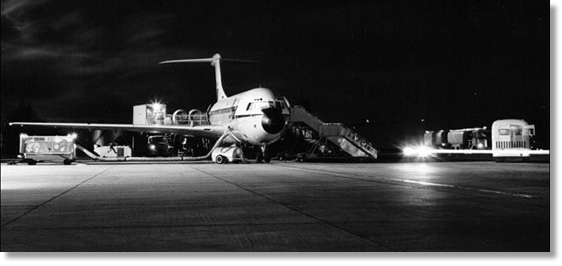
It didn't take long to learn that the arrival of the 2 Pallet/108 passenger fit schedule ex-UK had resulted in a a single pallet offload for Gan. The passengers, mainly for a Navy ship's crew rotation in Singapore, having been bussed up to our passenger terminal; the infamous Blue Lagoon Transit Hotel, aka "The Golden Flip Flop". The other pallet remaining on board was a Navy AOG spare engine for a sick helicopter in Singapore.
It was the sequence of the offload and refuel that was the cause of the aircraft still being on the ramp. Do any of the 'oldies' remember the chance that the VC10 air frame twisting post the freight door opening, the pallet shifting, the refuel and the final closing of the freight door? I'm sure it is now obvious - the sequence and the final door closing required the ''shoot bolts'' that locked all the door clamps to be confirmed and every so often it failed.
It was the sequence of the offload and refuel that was the cause of the aircraft still being on the ramp. Do any of the 'oldies' remember the chance that the VC10 air frame twisting post the freight door opening, the pallet shifting, the refuel and the final closing of the freight door? I'm sure it is now obvious - the sequence and the final door closing required the ''shoot bolts'' that locked all the door clamps to be confirmed and every so often it failed.
My next enquiries were to check to see if the normal Route options to release the twist and allow the shoot bolts to be locked had been attempted:
1. Open the emergency exits and despatch several chaps out onto the wing to perform a little dance number as the techies attempted to shut and lock the freight door - if this failed then...
2. Attach the towing tractor and move the aircraft forward over the nose wheel chocks.
The intent from both technical solutions being to effectively shock the shoot bolts into the correct locking. Ho-hum, both had been tried and neither had worked so the techies were in consultation with RAF Brize Norton and HQ 46 Group as to a solution - bear in mind there were no mobile phones, no social media and no e-mails to ease the conversation; it was teleprinters and HF radio links which were neither easy nor speedy.
I had a meaningful discussion with the techies which prompted the infamous - "More news in two hours" so I now launched myself back to the Blue Lagoon to brief the passengers and to try and gain some understanding of their frame of mind after some six hours of delay. Not a happy bunch of campers and my update suggesting further news in two hours was met with howls of derision!
Regrettably, it was the best available update. This comedy routine of me taking the continuing "delay status and next briefs" back to the passengers lasted for the whole shift and the level of angst was not improving - I seem to recall my parentage being doubted, what is now known a "unacceptable abuse" was the order of the day linked to a real desire from the passengers to know what was happening.
1. Open the emergency exits and despatch several chaps out onto the wing to perform a little dance number as the techies attempted to shut and lock the freight door - if this failed then...
2. Attach the towing tractor and move the aircraft forward over the nose wheel chocks.
The intent from both technical solutions being to effectively shock the shoot bolts into the correct locking. Ho-hum, both had been tried and neither had worked so the techies were in consultation with RAF Brize Norton and HQ 46 Group as to a solution - bear in mind there were no mobile phones, no social media and no e-mails to ease the conversation; it was teleprinters and HF radio links which were neither easy nor speedy.
I had a meaningful discussion with the techies which prompted the infamous - "More news in two hours" so I now launched myself back to the Blue Lagoon to brief the passengers and to try and gain some understanding of their frame of mind after some six hours of delay. Not a happy bunch of campers and my update suggesting further news in two hours was met with howls of derision!
Regrettably, it was the best available update. This comedy routine of me taking the continuing "delay status and next briefs" back to the passengers lasted for the whole shift and the level of angst was not improving - I seem to recall my parentage being doubted, what is now known a "unacceptable abuse" was the order of the day linked to a real desire from the passengers to know what was happening.
Given the loss of an engine would have been solved by using the Conway spare held at Gan and possibly an 8-10 hour delay maximum, it was very challenging as to the explanation being passed to the irate passengers. I made the average lying MP look totally honest with my attempts to dream up ways of saying - the next brief will be in two hours and the ongoing problem and final test will be completed soonest.
Finally, at about 1600 hrs I made the decision to be honest - yes me Gov! I grabbed the microphone from the Blue Lagoon Duty Corporal (Rocky) and made an announcement to the assembled masses... hence the THY981 reference, "You will all be aware of the aircraft crash in Paris on Sunday and the dreadful loss of life, well, its a similar technical fault with your VC10, namely the main freight door is refusing to lock correctly which would result in a similar incident if the aircraft was despatched without an approved fix." Stunned silence, many pale and shocked faces! To their credit I was then treated to a round of applause (I think) and then many mutterings of thanks for being honest, best of luck to the techies etc.
Some two hours later the techies determined that the aircraft was fit to fly, with the freight door closed and the shoot bolts wire-locked (meaning the door was not opened until the aircraft finally got back to Brize, i.e. GAN, SIN, GAN, AKT, BZZ - about 36 hours late, still carrying the AOG engine). The dejected and tired but understanding Navy passengers were re-boarded and the aircraft departed. Yes, the freight boys along the route were not happy that a pallet position was wasted but the aircraft did get home and no casualties other than some robust Inter-Service banter.
A personal thought: RAF Gan was unique and the Movers were critical for a huge range of essential services - fresh food, Gozzome Flights, the offloading and handling of cargo ships etc. Most importantly the camaraderie of the entire unit was fantastic but the Movers, before and after my stint, proved to be excellent in a team sense but above all were fantastic individuals. I could bore people to death about Dhoni racing, playing rugby and taking down the posts to prevent obstructions for aircraft activity etc., the cinema and disco nights with the nurses!
For those who would love to see some great Gan photos may I recommend - www.pprune.org You will find a superb page entitled RAF Gan 1958 & Later which includes a scanned copy of the London Illustrated News from 1970 all about Gan.
Cheers, Ian
(DAMO Gan, Dec '73 - Sep '74)
Finally, at about 1600 hrs I made the decision to be honest - yes me Gov! I grabbed the microphone from the Blue Lagoon Duty Corporal (Rocky) and made an announcement to the assembled masses... hence the THY981 reference, "You will all be aware of the aircraft crash in Paris on Sunday and the dreadful loss of life, well, its a similar technical fault with your VC10, namely the main freight door is refusing to lock correctly which would result in a similar incident if the aircraft was despatched without an approved fix." Stunned silence, many pale and shocked faces! To their credit I was then treated to a round of applause (I think) and then many mutterings of thanks for being honest, best of luck to the techies etc.
Some two hours later the techies determined that the aircraft was fit to fly, with the freight door closed and the shoot bolts wire-locked (meaning the door was not opened until the aircraft finally got back to Brize, i.e. GAN, SIN, GAN, AKT, BZZ - about 36 hours late, still carrying the AOG engine). The dejected and tired but understanding Navy passengers were re-boarded and the aircraft departed. Yes, the freight boys along the route were not happy that a pallet position was wasted but the aircraft did get home and no casualties other than some robust Inter-Service banter.
A personal thought: RAF Gan was unique and the Movers were critical for a huge range of essential services - fresh food, Gozzome Flights, the offloading and handling of cargo ships etc. Most importantly the camaraderie of the entire unit was fantastic but the Movers, before and after my stint, proved to be excellent in a team sense but above all were fantastic individuals. I could bore people to death about Dhoni racing, playing rugby and taking down the posts to prevent obstructions for aircraft activity etc., the cinema and disco nights with the nurses!
For those who would love to see some great Gan photos may I recommend - www.pprune.org You will find a superb page entitled RAF Gan 1958 & Later which includes a scanned copy of the London Illustrated News from 1970 all about Gan.
Cheers, Ian
(DAMO Gan, Dec '73 - Sep '74)
From: Andrew Downard, Ballarat, VIC
Subject: Memories of RAF Gan
Any tour on Gan was the best holiday ever! Even getting cut-off when the Cyprus invasion happened and no flights passed through (no shifts 😉) was no problem for those of us too poor or ugly to have a girlfriend/wife back home.
My enduring memory of Gan was the Marine Bar, being always a great night. On a really, really good night there might be a ‘New Chum’ just arrived and visiting the Bar for the first time.
Subject: Memories of RAF Gan
Any tour on Gan was the best holiday ever! Even getting cut-off when the Cyprus invasion happened and no flights passed through (no shifts 😉) was no problem for those of us too poor or ugly to have a girlfriend/wife back home.
My enduring memory of Gan was the Marine Bar, being always a great night. On a really, really good night there might be a ‘New Chum’ just arrived and visiting the Bar for the first time.
Someone would sidle up to them and suggest they had the makings of a “Marine Bar Spoons Champion” who could surely beat the current Champ (points to large specimen at other side of the bar). After a suitable amount of beer had been consumed by the prospective champ the large specimen would loudly issue a challenge for anyone brave enough to take him on in a game of spoons. The New Chum would find themselves pushed to the front of the pack.
The rules were simple, each player would take a large spoon from the mess in their mouths, kneel opposite each other with the head down and swing it to hit the other player on the head. The Champ would generously offer the New Chum first strike.
See the video at left to get a gist of the prank. Usually the New Chum became a leading part of future spoon contests for the rest of their tour.
Another great memory was snorkeling off the back of the Air Movements offices by the Beach Hut. Saw my first Reef Shark there and have been jumping in the water and photographing them ever since. Have always wanted to go back to the Maldives but haven’t made it yet.
The rules were simple, each player would take a large spoon from the mess in their mouths, kneel opposite each other with the head down and swing it to hit the other player on the head. The Champ would generously offer the New Chum first strike.
See the video at left to get a gist of the prank. Usually the New Chum became a leading part of future spoon contests for the rest of their tour.
Another great memory was snorkeling off the back of the Air Movements offices by the Beach Hut. Saw my first Reef Shark there and have been jumping in the water and photographing them ever since. Have always wanted to go back to the Maldives but haven’t made it yet.
From: Gordon Gray, Allestree, Derby
Subject: RAF Gan
Tony Hi,
My memories of RAF Gan are still very vivid after 52 years. Firstly, it was my initial overseas posting in November 1964, less than 2 years out from Apprentice Supply training, secondly because the environment of the place left a lot to the imagination before first landing on a 'postage stamp' size airfield on a coral reef, south of the Equator. With just a long runway a few feet above sea level, totally flat, half surrounded on one side with a vast aircraft parking pan and numerous closely packed tropical huts, all this surrounded by turquoise blue sea.
For an unmarried airman, as I was, life was idyllic. Movements, which covered air and sea was my first experience in the trade. Being allocated to Freight, a day job with a remit to shift cargo from aircraft offload to Supply Section and vice versa was not a particularly demanding role for a couple of months and one I accepted until successfully pestering my boss at the time, Flt Lt Filbey, to go on Trims and Load Control.
We had two small teams of Maldivian labourers to contend with aircraft load handling, supervised by a Cpl. The seemingly frequent movement of replacement Proteus engines as a result of Britannia engine changes, often requiring re-roles, invariably generated some squabbling among the local labourers, but they were generally good workers.
Subject: RAF Gan
Tony Hi,
My memories of RAF Gan are still very vivid after 52 years. Firstly, it was my initial overseas posting in November 1964, less than 2 years out from Apprentice Supply training, secondly because the environment of the place left a lot to the imagination before first landing on a 'postage stamp' size airfield on a coral reef, south of the Equator. With just a long runway a few feet above sea level, totally flat, half surrounded on one side with a vast aircraft parking pan and numerous closely packed tropical huts, all this surrounded by turquoise blue sea.
For an unmarried airman, as I was, life was idyllic. Movements, which covered air and sea was my first experience in the trade. Being allocated to Freight, a day job with a remit to shift cargo from aircraft offload to Supply Section and vice versa was not a particularly demanding role for a couple of months and one I accepted until successfully pestering my boss at the time, Flt Lt Filbey, to go on Trims and Load Control.
We had two small teams of Maldivian labourers to contend with aircraft load handling, supervised by a Cpl. The seemingly frequent movement of replacement Proteus engines as a result of Britannia engine changes, often requiring re-roles, invariably generated some squabbling among the local labourers, but they were generally good workers.
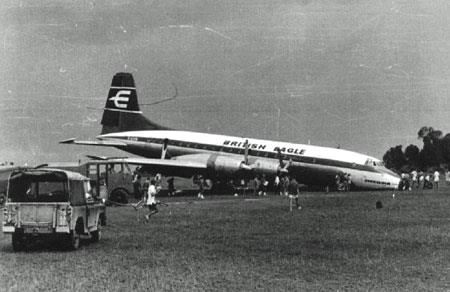
G-AOVB was badly damaged after a heavy landing at Gan in the Maldive Islands on the 10th October 1965.
It crashed on an inbound trooping flight from Bahrain
to Australia, with 120 passengers onboard
to Australia, with 120 passengers onboard
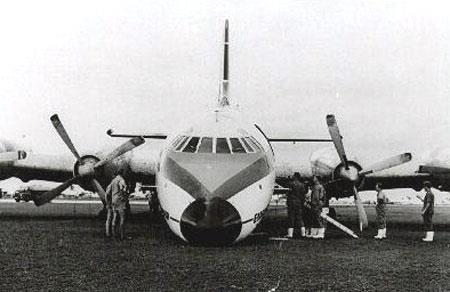
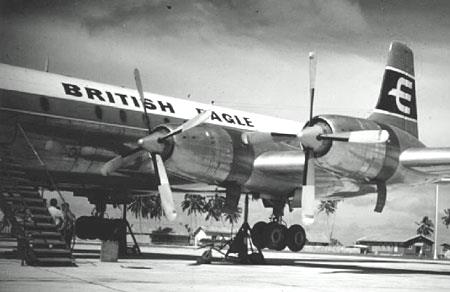
A maintenance team was sent from London to repair
the damaged aircraft, with help from the RAF
the damaged aircraft, with help from the RAF
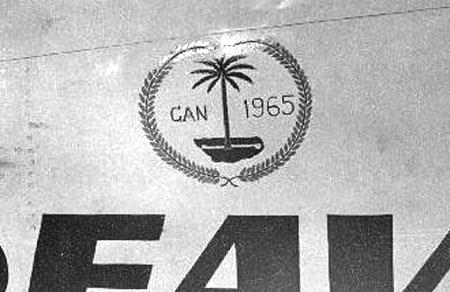
The RAF applied the nose art to the front of the plane
Highlights of those 12 months include sadly, one night in October '65 when a British Eagle Britannia broke its' nose oleo leg after bouncing on approach during one of the frequent heavy squalls we used to suffer. The sad part of this was the ploughing up of the cherished golf course; fortunately there were no casualties and the course was soon repaired. The aircraft took a little longer.
Aircraft movements comprised regular schedules to and from UK to the Far East on Trooping runs. We had a daily Britannia and twice weekly Comet from Lyneham, plus other types from FEAF, MEAF, NEAF and a weekly British Eagle Britannia through to Cocos Island and beyond. The inevitable frequent delays of aircraft caused headaches for all handling aspects not least of us trim clerks with only one of us on each shift, dashing from one aircraft to another. Crews were generally sympathetic on these occasions but trim sheets were never done by AQM's in those days and always completed on the aircraft during turn - round. If it was an unplanned night stop due to unserviceability, it was back in the office with last minute variations to loads. In those days air conditioning was a luxury but generally unheard of so if the engineers were still rectifying a problem it was more comfortable to stay for a while on the aircraft with the coolers blowing into the cabin.
Aircraft movements comprised regular schedules to and from UK to the Far East on Trooping runs. We had a daily Britannia and twice weekly Comet from Lyneham, plus other types from FEAF, MEAF, NEAF and a weekly British Eagle Britannia through to Cocos Island and beyond. The inevitable frequent delays of aircraft caused headaches for all handling aspects not least of us trim clerks with only one of us on each shift, dashing from one aircraft to another. Crews were generally sympathetic on these occasions but trim sheets were never done by AQM's in those days and always completed on the aircraft during turn - round. If it was an unplanned night stop due to unserviceability, it was back in the office with last minute variations to loads. In those days air conditioning was a luxury but generally unheard of so if the engineers were still rectifying a problem it was more comfortable to stay for a while on the aircraft with the coolers blowing into the cabin.
V-Force aircraft movements during exercises were always a spectacle arriving and departing during daylight. They were not too popular during the night-time early hours though as our accommodation just opposite 180 Club being closest to the runway, could always guarantee a sleepless hour with perhaps four Vulcans on the move whichever way taking off.
For most of us Movers, British Eagle hostesses were our favourites, not just because they were female but on the way out to Cocos we would request a couple of crates of fresh milk to be dropped off on their return. Those fleeting moments did wonders for our morale! During the India-Pakistan war in 1965, aircraft traffic routed though Ceylon was displaced by those originally transiting through India which in turn put Gan as the ideal diversion for Ceylon traffic to stage through. A couple of occasions gave TASF acute parking problems with aircraft literally nose to tail awaiting space to park.
Light relief was always welcome away from our regular jobs by turning our hands to offloading merchant vessels. Generally, Movers would be rostered each month and support would come from Changi to look after Air Movements. Charcoal was always in demand for the NAAFI and there was nothing more soul destroying than tallying sacks and pallets of the stuff out of ships holds and being covered from head to toe with black dust. But Tiger beer was generally compensation for our discomfort at the end of the day.
For most of us Movers, British Eagle hostesses were our favourites, not just because they were female but on the way out to Cocos we would request a couple of crates of fresh milk to be dropped off on their return. Those fleeting moments did wonders for our morale! During the India-Pakistan war in 1965, aircraft traffic routed though Ceylon was displaced by those originally transiting through India which in turn put Gan as the ideal diversion for Ceylon traffic to stage through. A couple of occasions gave TASF acute parking problems with aircraft literally nose to tail awaiting space to park.
Light relief was always welcome away from our regular jobs by turning our hands to offloading merchant vessels. Generally, Movers would be rostered each month and support would come from Changi to look after Air Movements. Charcoal was always in demand for the NAAFI and there was nothing more soul destroying than tallying sacks and pallets of the stuff out of ships holds and being covered from head to toe with black dust. But Tiger beer was generally compensation for our discomfort at the end of the day.
Apart from regular diversions away from work helping pass the time, there was always active sport of some sort, from water ski-ing, go -karting, tennis, owning a canoe (inheriting one), strolling around the island perimeter road, cinema as well as the occasional CSE show (Frankie Howard and Shirley Abicair during '65 spring to mind), regular soccer matches for those inclined and the usual swim off the sandy beaches on the lagoon side. Mah Jong, a set procured from Changi Movers, proved a compulsive pastime outside on the billet verandah for a few of us.
Other ways of breaking out for us Movers was the opportunity to take a Supernumerary seat on the monthly Hastings from Changi which ferried the Ceylonese and Pakistani workers home on leave. Staging through to Karachi via Katunayake and return included a night stop in the KLM Royal Dutch Hotel Karachi. A direct route to Karachi was a 13 hour flight and, having loaded up at Gan with all the personal possessions of the pax, with a PCF load of humans after a tiring uphill slog on the inclined floor, just imagine the air quality after all those flying hours - then a replicated return load - all good character building.
Just spending a few hours away from the Gan terrain could involve a Beacon Calibration flight of an hour or so aboard the regularly attached Hastings or the locally based Search and Rescue Shackleton also attached to us. But there was always the option of a lagoon crossing on one of the Marine Craft Unit's LCGP to the northern most island Hitaddu. That could involve a return soccer match and a night stopover meeting some new faces of the guys manning the communications site and of course enjoying another location for several or more beers.
The 180 Club, across the road from our billet, was a great refuge during the evenings off duty, but it served for us airmen an occasional useful facility for visiting speakers. One particular scholar from a UK university gave an interesting insight into the Vietnam War, which during that period in 1965 had devastating effect on many countries cultures in the region, not least of all the United States.
Other ways of breaking out for us Movers was the opportunity to take a Supernumerary seat on the monthly Hastings from Changi which ferried the Ceylonese and Pakistani workers home on leave. Staging through to Karachi via Katunayake and return included a night stop in the KLM Royal Dutch Hotel Karachi. A direct route to Karachi was a 13 hour flight and, having loaded up at Gan with all the personal possessions of the pax, with a PCF load of humans after a tiring uphill slog on the inclined floor, just imagine the air quality after all those flying hours - then a replicated return load - all good character building.
Just spending a few hours away from the Gan terrain could involve a Beacon Calibration flight of an hour or so aboard the regularly attached Hastings or the locally based Search and Rescue Shackleton also attached to us. But there was always the option of a lagoon crossing on one of the Marine Craft Unit's LCGP to the northern most island Hitaddu. That could involve a return soccer match and a night stopover meeting some new faces of the guys manning the communications site and of course enjoying another location for several or more beers.
The 180 Club, across the road from our billet, was a great refuge during the evenings off duty, but it served for us airmen an occasional useful facility for visiting speakers. One particular scholar from a UK university gave an interesting insight into the Vietnam War, which during that period in 1965 had devastating effect on many countries cultures in the region, not least of all the United States.
Our Sick Quarters was regularly called upon to support an incident, be it a simple coral cut on the body to more serious situations. One of their main remits was the health of not just service personnel but supporting the local populace and that involved midwifery. Regular Tannoy announcements would call out a name for certain airman to report to SSQ immediately for blood transfusion, that was generally a requirement for a local woman during or after childbirth.
Discussions among us often turned to what might happen in the future whenever Britain relinquished the Island and the Atoll to the government in Male. Thoughts of a tropical paradise have come to fruition as it has turned to tourism on a grand scale. But during those 12 month tours of the 60's and 70's when we 600 or so Servicemen on duty were relatively safe in that insular environment, sympathy often turned to the guys elsewhere in the Gulf areas particularly Aden and the Indonesian hostilities.
Several years ago I purchased a book, 'From Port T to RAF Gan' written by a retired RAF Education Officer, a fascinating compilation of the history of the Island and the Atoll from WW 2 up to 1976. Although at the time of my 12 month tour it was known that the political situation with the locals was a bit turbulent, the book really expounds the very nature of the involvement of not just the RAF, the Foreign Office and the Male Government but the local Addu Atoll Maldivians in their efforts to maintain their own independence.
Seeing the news of a Voyager departing Brize today with troops for Estonia, now 50 years on, we're still making an impact!
Discussions among us often turned to what might happen in the future whenever Britain relinquished the Island and the Atoll to the government in Male. Thoughts of a tropical paradise have come to fruition as it has turned to tourism on a grand scale. But during those 12 month tours of the 60's and 70's when we 600 or so Servicemen on duty were relatively safe in that insular environment, sympathy often turned to the guys elsewhere in the Gulf areas particularly Aden and the Indonesian hostilities.
Several years ago I purchased a book, 'From Port T to RAF Gan' written by a retired RAF Education Officer, a fascinating compilation of the history of the Island and the Atoll from WW 2 up to 1976. Although at the time of my 12 month tour it was known that the political situation with the locals was a bit turbulent, the book really expounds the very nature of the involvement of not just the RAF, the Foreign Office and the Male Government but the local Addu Atoll Maldivians in their efforts to maintain their own independence.
Seeing the news of a Voyager departing Brize today with troops for Estonia, now 50 years on, we're still making an impact!
From: Neil Middleton, Ipswich, Suffolk
Subject: Memories of RAF Gan
Dear Tony,
My memory of Gan is that I had my very first "game!!!" of golf there in 1972.
We were heading out to Port Villa in the New Hebrides and we had a stop-over there. We borrowed some clubs from the club house and bought 6 balls each and set off, by the second hole I had lost all 6 of my balls, so that was the end for me, so back to the 19th hole.
If my memory serves me right the course was made of clover, it was lovely.
Rgds, Neil
Subject: Memories of RAF Gan
Dear Tony,
My memory of Gan is that I had my very first "game!!!" of golf there in 1972.
We were heading out to Port Villa in the New Hebrides and we had a stop-over there. We borrowed some clubs from the club house and bought 6 balls each and set off, by the second hole I had lost all 6 of my balls, so that was the end for me, so back to the 19th hole.
If my memory serves me right the course was made of clover, it was lovely.
Rgds, Neil
From: David Stevens, Bangor
Subject: Memories of RAF Gan
Hi Tony,
I had several close encounters with RAF Gan although I was never posted there.
1. Staged and over-nighted in RAF Gan several times with UKMAMS when tasked with missions in FEAF including confrontations in Borneo; circa 1964-66.
2. I was escort officer for an all party Parliamentary delegation to China and went as far as Kai Tak then I flew to RAF Gan and enjoyed a few days sailing before returning to Hong Kong to collect my party of MPs.
3. When I was SO(Mov) to IATS, I called into RAF Gan on a couple of occasions. After doing the official bit I did some more sailing. It was a hard life in those days circa 1973-74.
Subject: Memories of RAF Gan
Hi Tony,
I had several close encounters with RAF Gan although I was never posted there.
1. Staged and over-nighted in RAF Gan several times with UKMAMS when tasked with missions in FEAF including confrontations in Borneo; circa 1964-66.
2. I was escort officer for an all party Parliamentary delegation to China and went as far as Kai Tak then I flew to RAF Gan and enjoyed a few days sailing before returning to Hong Kong to collect my party of MPs.
3. When I was SO(Mov) to IATS, I called into RAF Gan on a couple of occasions. After doing the official bit I did some more sailing. It was a hard life in those days circa 1973-74.
From: Peter Clayton, Wroughton, Wilts
Subject: Memories of RAF Gan
Hi Tony,
My first visit to RAF Gan was in 1967 when I was posted out to RAF Changi, only a brief stop for fuel but the place interested me. However during my next tour to Kai -Tak I took the opportunity of going to Gan for a week to visit a friend that I had met in Singapore a few years earlier.
Nobody could quite believe that I had left Hong Kong to spend a week on Gan but to me it was a nice change from the manic roads and noise of Hong Kong. I also stopped on a few other occasions when going home from Singapore and Hong Kong, amazingly on one occasion I was in the Blue Lagoon Transit Bar and I saw my Dad (Flit Clayton) who was passing through as a pilot, as he often did, on the Hastings of 48 Squadron from RAF Changi, I know that he had a love of the Island.
Subject: Memories of RAF Gan
Hi Tony,
My first visit to RAF Gan was in 1967 when I was posted out to RAF Changi, only a brief stop for fuel but the place interested me. However during my next tour to Kai -Tak I took the opportunity of going to Gan for a week to visit a friend that I had met in Singapore a few years earlier.
Nobody could quite believe that I had left Hong Kong to spend a week on Gan but to me it was a nice change from the manic roads and noise of Hong Kong. I also stopped on a few other occasions when going home from Singapore and Hong Kong, amazingly on one occasion I was in the Blue Lagoon Transit Bar and I saw my Dad (Flit Clayton) who was passing through as a pilot, as he often did, on the Hastings of 48 Squadron from RAF Changi, I know that he had a love of the Island.
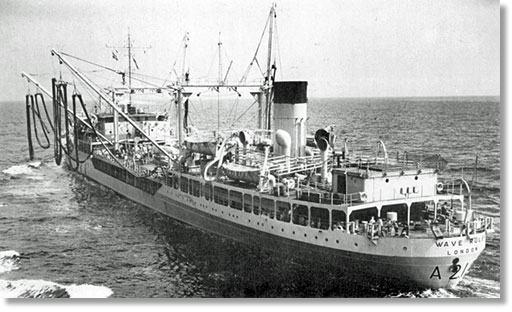
I spent most of the week snorkelling and diving around the Island and had a very interesting dive under the RFA Wave Ruler, where the tropical fish actually turned upside down as they came in from the surrounding water, to them it was just another reef as the hull was covered in soft coral of all colours.
The Wave Ruler was an old RFA ship that was used as a fuel hulk for the military aircraft at Gan, she arrived there in 1970 and was sold for scrap in 1976 and eventually left Gan under tow. Interestingly, the RFA Wave Ruler was also used at Christmas Island during the 'H' bomb tests.
I was also lucky to go on a trip to Hittadu, another Island within Addu Atoll that was home to the 'Hittadu Hermits' or rather the signals and comms guys. They had a very nice beach bar set up where the walls were adorned with women's knickers, apparently it was tradition for any women that visited the Island to 'donate' their undies! I bet there will be some stories from those days no doubt!
The Wave Ruler was an old RFA ship that was used as a fuel hulk for the military aircraft at Gan, she arrived there in 1970 and was sold for scrap in 1976 and eventually left Gan under tow. Interestingly, the RFA Wave Ruler was also used at Christmas Island during the 'H' bomb tests.
I was also lucky to go on a trip to Hittadu, another Island within Addu Atoll that was home to the 'Hittadu Hermits' or rather the signals and comms guys. They had a very nice beach bar set up where the walls were adorned with women's knickers, apparently it was tradition for any women that visited the Island to 'donate' their undies! I bet there will be some stories from those days no doubt!
It was a great week with plenty of sun, diving, snorkelling, beer and late night visits to the in flight catering section for some triple cooked chips, courtesy of my mate who was in catering.
My next visit in 1975 was a working trip with UKMAMS from Lyneham on Hercules XV209 'Reindeer Special' to spend the last Christmas at Gan on standby in case of any emergencies in the Far East over the Christmas period. We flew out via Akrotiri, Masirah, Gan, Tengah (Singapore) and back to Gan for 4 days. I do remember that we had quite a party when we got back from Tengah and no doubt a few more over the Christmas, when we left a low flypast of Addu Atoll was carried out before we set off for Masirah, Akrotiri and Lyneham in time for New Year.
If you have never been to RAF Gan take a look on the internet, there are some videos and photos and even a website dedicated to those that were lucky enough to have served on the Island, there is even a group that has made return visits quite recently and how it must have changed but still a wonderful place in my opinion.
Peter
My next visit in 1975 was a working trip with UKMAMS from Lyneham on Hercules XV209 'Reindeer Special' to spend the last Christmas at Gan on standby in case of any emergencies in the Far East over the Christmas period. We flew out via Akrotiri, Masirah, Gan, Tengah (Singapore) and back to Gan for 4 days. I do remember that we had quite a party when we got back from Tengah and no doubt a few more over the Christmas, when we left a low flypast of Addu Atoll was carried out before we set off for Masirah, Akrotiri and Lyneham in time for New Year.
If you have never been to RAF Gan take a look on the internet, there are some videos and photos and even a website dedicated to those that were lucky enough to have served on the Island, there is even a group that has made return visits quite recently and how it must have changed but still a wonderful place in my opinion.
Peter
Re-supply Ship. About every 4 months or so, RAF Gan would be re-supplied by sea , courtesy of Brocklebank Line, with all its food and other bulk requirements, especially the NAAFI supplies of alcoholic refreshments including draught bitter (but there was NEVER enough!). I think it took about 3-4 days to turn the ship around and in conjunction with the Marine Craft section using their landing craft a Movements shift was allocated to supervise the unloading . I was thankful that my team leader, Cpl John Morris, was already familiar with the routine for my first ship and no hiccups occurred. However, I do remember that we had to keep a gentle eye on our Shipping clerk, a very cheerful Cpl whose name I think was McCarthy, who was always ‘looked after’ very well by the ship’s Purser. I decided to tactfully decline the purser’s hospitality. In those days all the cargo was loose loaded and had to be manhandled and hoisted onto the landing craft. It was hot, hard work down in the holds and fortunately most of that work was carried out by a working party of local Maldivians. I vaguely remember it rained during one of the ship offloads which made life a little more interesting regarding safety.
The Movements Section. I am afraid being such a long time ago I am struggling with names. I think our Section SNCO was Sgt Arthur Cole. Whoever it was, he proved to be excellent at managing all the various activities of the section. This included saving me from a potentially embarrassing situation on a CO’s inspection when a certain WRAF ALM was in my office at the moment I should have been outside waiting for the CO’s car! As for my team, in addition Cpl John Morris, there were SACs John Terry and Tudor– I do not recall Tudor being referred to by any other name. Nonetheless, I do remember very clearly we lost him one very dark night when we were turning round a Britannia and John Morris went round the belly holds calling out “Tudor – smile!” He eventually found him in one of them busily lashing down. (This may appear to be non-PC nowadays, but no offence was intended nor taken by Tudor, who had a very good sense of humour – something very necessary in the Gan environment!) I am afraid I cannot remember now how many made up each team; I am sure I am missing a trim clerk and possibly others. I am very sorry to those whom I cannot remember, but it is 48 yrs ago.
Others at Gan. I daresay most people passing through Gan might have assumed that there were only RAF and Maldivians at Addu Attol. Gan was the largest island, aligned very neatly E-W at the southern edge of the attol. The only other island on which RAF personnel were permitted was Hittadu at the NW edge where the communications facilities were installed. To help maintain all the various facilities on the base, about 15 MPBW staff were also posted to Gan. (For those who do not recognise the initials MPBW, they stand for Ministry of Public Buildings and Works, not to be confused with the other Ministry of Public Blunders and Wonders). They had their own mess and employed a fairly large number of Pakistanis who had their own camp on the south side of the runway. The Pakistani camp was self sufficient and RAF personnel were able to eat there for a small fee, which provided a very pleasant evening out from time to time. Whilst at Gan I was mess secretary and my clerk was a Ceylonese (as they were known then). He was an excellent fellow who kept the books very neat and straight.
The Movements Section. I am afraid being such a long time ago I am struggling with names. I think our Section SNCO was Sgt Arthur Cole. Whoever it was, he proved to be excellent at managing all the various activities of the section. This included saving me from a potentially embarrassing situation on a CO’s inspection when a certain WRAF ALM was in my office at the moment I should have been outside waiting for the CO’s car! As for my team, in addition Cpl John Morris, there were SACs John Terry and Tudor– I do not recall Tudor being referred to by any other name. Nonetheless, I do remember very clearly we lost him one very dark night when we were turning round a Britannia and John Morris went round the belly holds calling out “Tudor – smile!” He eventually found him in one of them busily lashing down. (This may appear to be non-PC nowadays, but no offence was intended nor taken by Tudor, who had a very good sense of humour – something very necessary in the Gan environment!) I am afraid I cannot remember now how many made up each team; I am sure I am missing a trim clerk and possibly others. I am very sorry to those whom I cannot remember, but it is 48 yrs ago.
Others at Gan. I daresay most people passing through Gan might have assumed that there were only RAF and Maldivians at Addu Attol. Gan was the largest island, aligned very neatly E-W at the southern edge of the attol. The only other island on which RAF personnel were permitted was Hittadu at the NW edge where the communications facilities were installed. To help maintain all the various facilities on the base, about 15 MPBW staff were also posted to Gan. (For those who do not recognise the initials MPBW, they stand for Ministry of Public Buildings and Works, not to be confused with the other Ministry of Public Blunders and Wonders). They had their own mess and employed a fairly large number of Pakistanis who had their own camp on the south side of the runway. The Pakistani camp was self sufficient and RAF personnel were able to eat there for a small fee, which provided a very pleasant evening out from time to time. Whilst at Gan I was mess secretary and my clerk was a Ceylonese (as they were known then). He was an excellent fellow who kept the books very neat and straight.
Bersatu Padu. Without going into any details, suffice it to say that this was a major UK reinforcement exercise of Singapore in an attempt to show that the UK could still ‘do it’ following our withdrawal from ‘East of Suez’ as instigated by the Wilson government of the time. It took place over several weeks and kept all at Gan pretty busy 24hrs a day during the deployment and recovery phases. When I caught up with Chris Heyland at Changi the following year, it became very obvious from his tales of his Changi experience during BP,that we at Gan had got off pretty lightly. Nevertheless, it was just as well no re-supply ship was scheduled for Gan during this period.
Mover ‘Experiences’. No doubt every mover has experienced the call from Ops, if not the aircraft Captain, for a quick turnaround as the flight was behind schedule. Obviously such an opportunity regarding a VC10 flight at Gan presents a degree of rivalry between shifts, particularly movements and to a lesser extent the flight servicing teams taking into account safety. Quite regularly the turnarounds would be less than 50 mins but then Chris Twyman’s shift (Chris took over from Paddy Pearce) achieved something in the region of 40 mins. One problem was the time taken to actually get the pax off the aircraft to commence certain aspects of the servicing while at the other end of the window the time taken to get the passengers out of the Transit Hotel back onto the aircraft was often much too slow. However, one day, as luck would have it, my team and the ALM were clearly watching keenly how things were going and suggested that the passengers should be coached down to the pan ready to board as soon as the Captain gave the OK. Just before the 2nd coach arrived on the pan (it wasn’t too hot that day) the OK was given and chocks out were achieved in 33 mins. A small achievement on that occasion but on another I ended up on the carpet in front of OC Admin, Sqn Ldr Blanchard (?) who ripped me off for speeding down Equator Way to the Transit Hotel right at the end of the turnaround time because of a problem down there which had been solved by the time I arrived. The speed limit throughout the island was 30mph – I must have clicked 60mph and the screeching of my Landrover at high revs could be easily heard in SHQ without anyone telling him who it was! A more concerning incident was when the Channelling Cabin (weighing circa 8,000 lbs, perhaps more) of the Skynet Communications facility for Gan slid off the back of the 25K Condec Transfer Loader. Fortunately no-one was hurt but the electronics contents of the cabin (some £ms!!) were written off. As a result of the subsequent Unit Enquiry the procedures concerning the lashing down roller conveyor loads on a Condec were changed to state that a load must be lashed down immediately it was on the Condec..... and never to rely on the chock at the end of the Condec , even if only slightly adjusting the platform!
Mover ‘Experiences’. No doubt every mover has experienced the call from Ops, if not the aircraft Captain, for a quick turnaround as the flight was behind schedule. Obviously such an opportunity regarding a VC10 flight at Gan presents a degree of rivalry between shifts, particularly movements and to a lesser extent the flight servicing teams taking into account safety. Quite regularly the turnarounds would be less than 50 mins but then Chris Twyman’s shift (Chris took over from Paddy Pearce) achieved something in the region of 40 mins. One problem was the time taken to actually get the pax off the aircraft to commence certain aspects of the servicing while at the other end of the window the time taken to get the passengers out of the Transit Hotel back onto the aircraft was often much too slow. However, one day, as luck would have it, my team and the ALM were clearly watching keenly how things were going and suggested that the passengers should be coached down to the pan ready to board as soon as the Captain gave the OK. Just before the 2nd coach arrived on the pan (it wasn’t too hot that day) the OK was given and chocks out were achieved in 33 mins. A small achievement on that occasion but on another I ended up on the carpet in front of OC Admin, Sqn Ldr Blanchard (?) who ripped me off for speeding down Equator Way to the Transit Hotel right at the end of the turnaround time because of a problem down there which had been solved by the time I arrived. The speed limit throughout the island was 30mph – I must have clicked 60mph and the screeching of my Landrover at high revs could be easily heard in SHQ without anyone telling him who it was! A more concerning incident was when the Channelling Cabin (weighing circa 8,000 lbs, perhaps more) of the Skynet Communications facility for Gan slid off the back of the 25K Condec Transfer Loader. Fortunately no-one was hurt but the electronics contents of the cabin (some £ms!!) were written off. As a result of the subsequent Unit Enquiry the procedures concerning the lashing down roller conveyor loads on a Condec were changed to state that a load must be lashed down immediately it was on the Condec..... and never to rely on the chock at the end of the Condec , even if only slightly adjusting the platform!
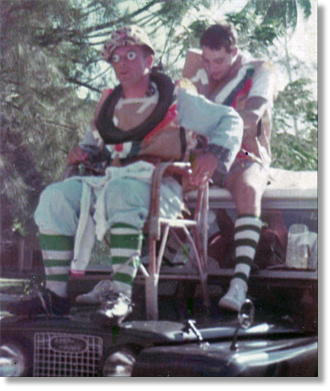
Christmas and New Year at Gan. Never to be forgotten! For a variety of reasons all operations down the route were suspended for a fortnight. So what does one do! Create a bar in every conceivable location. The normal number of mess and club bars on the island was about 14. That Christmas I believe the number exceeded 60. Apart from straining the right arm over such a long period, two recreational activities, which I remember particularly well, were the Christmas Day (or was it Boxing Day?) football match between the Officers’ and Sergeants’ messes. Quite a few dressed up in fancy dress and confusion reigned. Who won? I have no idea nor does anyone else!
Attached (hopefully) is a photograph of our captain, Padre Gareth Jones, sitting on his throne on the bonnet of the Movers’ Landrover, with myself (the writer) doing my utmost to hold him in place on the way to ‘Wembley Stadium’ for the match. Whilst talking about football, I think Geoff Haskell (Flt Lt, OC Supply Flt) may have been posted to us by then and would have definitely been playing. If not, he missed a good match without doubt!
Another hilarious activity at this time of year – and it could have been on New Year’s Day – was the annual boat race between 4 teams rowing whalers across the lagoon organised by Gan’s ‘Admiral’ and ‘Vice Admiral’ (OC and Dep Marine Craft Section – the latter’s surname was Bell so his other nickname was inevitably Ding-Dong). The varsity boat race had nothing on this race, albeit no boats sank but there was one hell of lot of shouting and balling by the coxswains at their amateur and definitely untrained crews. Who won and in what time? Who cares? Retire to the bar and quench that thirst!
Attached (hopefully) is a photograph of our captain, Padre Gareth Jones, sitting on his throne on the bonnet of the Movers’ Landrover, with myself (the writer) doing my utmost to hold him in place on the way to ‘Wembley Stadium’ for the match. Whilst talking about football, I think Geoff Haskell (Flt Lt, OC Supply Flt) may have been posted to us by then and would have definitely been playing. If not, he missed a good match without doubt!
Another hilarious activity at this time of year – and it could have been on New Year’s Day – was the annual boat race between 4 teams rowing whalers across the lagoon organised by Gan’s ‘Admiral’ and ‘Vice Admiral’ (OC and Dep Marine Craft Section – the latter’s surname was Bell so his other nickname was inevitably Ding-Dong). The varsity boat race had nothing on this race, albeit no boats sank but there was one hell of lot of shouting and balling by the coxswains at their amateur and definitely untrained crews. Who won and in what time? Who cares? Retire to the bar and quench that thirst!
From: Allan Henchoz, Llanfair Waterdine, Salop
Subject: RAF Gan 1969/70 – Memories of a 1st tour ‘Mover’
Pre-Posting. My posting to RAF Gan was the beginning of my first proper overseas tour. Prior to Gan I served at 30 MU, RAF Sealand, North Wales and then 32 MU, RAF St Athan, South Wales – hardly the best of locations in preparation for the tropics! However, I was in luck in that I was taking over from Chris Heyland as DMovO at RAF Gan who very kindly fixed me up with all the necessary KD kit from the tailors in Changi village (courtesy of a particular 10 Sqn ALM acting as courier). However, he also strongly recommended I brought with me all my rugby kit which was something I did not expect for that region, but I am glad I followed his advice! Unbeknown to me at the time, he was also one of a group of charismatic characters at Gan who had taken on nicknames of the characters of the Magic Roundabout TV programme.
Arrival at Gan. It was about 06:30 on a bright August morning when my VC10 landed at Gan; I was definitely blurry eyed and very unsure of what to expect as I descended the aircraft steps. At the bottom was Chris with a big smile (presumably because his ‘unaccompanied’ 1 year tour was now definitely up rather than delight at seeing me again!) and after a quick hand shake he whisked me off to the VIP lounge in the Transit Hotel at the other end of the island wherein I was immediately handed a beer and introduced to the other members of the Magic Roundabout ‘circle’ - the Rev Sqn Ldr Gareth Jones , Flt Lt Frank Dutton (Cat Off), Flt Lt ‘JJ’John Frazer (SMovO), Fg Off ‘Paddy’ Pearce (DMovO) , Fg Off Graham Bush (ATCO). I cannot remember who took on which character’s name but Chris told me I was now ‘Dougal’ and presented me with a tie with the ‘Dougal’ embroidered on it and which I still have. It was a brilliant welcome which tended to set the tone for the whole tour, thanks to Chris and the other Roundabouters!
Back to UK – Twice! Before a month was out I had to return to UK twice. The first time was because ATC refused to give me an airfield driving licence as I failed the Colour Sight Card test. According to their interpretation of the results, I could not distinguish between the green and red lights of the traffic lights at each end of the runway. Hence, I was flown back to UK to go to CME for a proper test. I was assessed as CP3 and therefore OK so back I went to Gan. But a few weeks later I was recalled to RAF St Athan to provide a Flt Cdr’s statement at the Court Martial of an airmen. Such toing and froing caused much comment on the island, mostly about not being able to stand the heat, etc. However, it was a very good way to get to know some of the VC10 crews, especially the ALMs.
Subject: RAF Gan 1969/70 – Memories of a 1st tour ‘Mover’
Pre-Posting. My posting to RAF Gan was the beginning of my first proper overseas tour. Prior to Gan I served at 30 MU, RAF Sealand, North Wales and then 32 MU, RAF St Athan, South Wales – hardly the best of locations in preparation for the tropics! However, I was in luck in that I was taking over from Chris Heyland as DMovO at RAF Gan who very kindly fixed me up with all the necessary KD kit from the tailors in Changi village (courtesy of a particular 10 Sqn ALM acting as courier). However, he also strongly recommended I brought with me all my rugby kit which was something I did not expect for that region, but I am glad I followed his advice! Unbeknown to me at the time, he was also one of a group of charismatic characters at Gan who had taken on nicknames of the characters of the Magic Roundabout TV programme.
Arrival at Gan. It was about 06:30 on a bright August morning when my VC10 landed at Gan; I was definitely blurry eyed and very unsure of what to expect as I descended the aircraft steps. At the bottom was Chris with a big smile (presumably because his ‘unaccompanied’ 1 year tour was now definitely up rather than delight at seeing me again!) and after a quick hand shake he whisked me off to the VIP lounge in the Transit Hotel at the other end of the island wherein I was immediately handed a beer and introduced to the other members of the Magic Roundabout ‘circle’ - the Rev Sqn Ldr Gareth Jones , Flt Lt Frank Dutton (Cat Off), Flt Lt ‘JJ’John Frazer (SMovO), Fg Off ‘Paddy’ Pearce (DMovO) , Fg Off Graham Bush (ATCO). I cannot remember who took on which character’s name but Chris told me I was now ‘Dougal’ and presented me with a tie with the ‘Dougal’ embroidered on it and which I still have. It was a brilliant welcome which tended to set the tone for the whole tour, thanks to Chris and the other Roundabouters!
Back to UK – Twice! Before a month was out I had to return to UK twice. The first time was because ATC refused to give me an airfield driving licence as I failed the Colour Sight Card test. According to their interpretation of the results, I could not distinguish between the green and red lights of the traffic lights at each end of the runway. Hence, I was flown back to UK to go to CME for a proper test. I was assessed as CP3 and therefore OK so back I went to Gan. But a few weeks later I was recalled to RAF St Athan to provide a Flt Cdr’s statement at the Court Martial of an airmen. Such toing and froing caused much comment on the island, mostly about not being able to stand the heat, etc. However, it was a very good way to get to know some of the VC10 crews, especially the ALMs.
Ladies at Gan. Yes, there were! Not just the aircrew WRAF ALMs and stewardesses staying during aircrew rest times at the Transit Hotel, but a WRVS lady was always stationed there. But then we had a WRAF Stn Accountant loaned to us from RAF Tengah, Fg Off Julie Doran. Julie was loaned to us because, very sadly, another great character at Gan, Flt Lt ‘Di’ Griffiths, had to be casevaced back to UK . I am not sure how long Julie stayed at Gan but her stay was unique in the history of the island.....until someone tells me otherwise. A final thought about ladies at Gan is that during this period 1969-70, three DMovOs who served at Gan in 1969 and/or 1970 married VC10 WRAF ALMs. I can’t help wondering whether, as a consequence, OC 10 Sqn suggested to Air Secs branch that they re-thought the posting criteria of young virile movers to Gan!
Rugby. Of all the sports to think of playing 8 miles south of the Equator, rugby does not spring to mind! Be this as it may, there were sufficient players and newcomers to muster two teams (or thereabouts) to enable some really good games to be played on a weekly basis. It did help to have on the island at least 2 FEAF players (from previous tours in Singapore) and a good coach, referee and O i/c in the form of Padre Gareth, (otherwise known as the Vicar of Gan). The highlight of our rugby ‘season’ which lasted all year round was when the Navy called in. They always produced a rugby team as well as football, golf etc. The matelots would normally roll us over in the first half but in th 2nd half we would (normally) triumph through speed, skill, agility and all the other adjectives you can think of!
The Tsunami that Never was. One day a signal came in from FEAF saying something along the lines that there had been an earthquake on or near the SW of Sumatra and a large tidal wave (the term Tsunami was not in use then) was heading Gan’s way with an ETA of 17:30. True to form the Vicar of Gan decided that if we were all to drown we might as well go happy. The highest point on the island was 6ft above sea level and the tidal wave was said to have been 100ft when it started its journey. So all of us not on duty and being of his flock (in mind if not in soul) gathered up a load of beer and went down to the beach from the Mess overlooking the lagoon at about 17:00, where we sat in the rattan chairs waiting patiently for ‘The End’. 5.30 came and went, 6.00pm came and went, but nothing had happened except the creation of a pile of empty beer cans. So we all retired back to the Mess for dinner. What ‘we’ had rather forgotten , apart from the fact that Gan was a long way away from Sumatra, was that the Addu Attoll has a substantial coral reef around it and also the Vicar had us pointing into the middle of the lagoon. It was a brilliant farewell party though.
Finito. It has been a very long time since my days at Gan and so if I have got any of the names wrong, or forgotten someone whom I should have really remembered, please forgive me. In comparison with some of those stationed with me, especially those who were married and separated from their families, I, as a ‘singly’, got off lightly although at the time many ‘singlies’ also felt they were missing a year of their life whilst stuck at Gan. Undoubtedly, it was a unique experience and on reflection it taught me an awful lot about myself, the job, about other people and especially about camaraderie.
Rugby. Of all the sports to think of playing 8 miles south of the Equator, rugby does not spring to mind! Be this as it may, there were sufficient players and newcomers to muster two teams (or thereabouts) to enable some really good games to be played on a weekly basis. It did help to have on the island at least 2 FEAF players (from previous tours in Singapore) and a good coach, referee and O i/c in the form of Padre Gareth, (otherwise known as the Vicar of Gan). The highlight of our rugby ‘season’ which lasted all year round was when the Navy called in. They always produced a rugby team as well as football, golf etc. The matelots would normally roll us over in the first half but in th 2nd half we would (normally) triumph through speed, skill, agility and all the other adjectives you can think of!
The Tsunami that Never was. One day a signal came in from FEAF saying something along the lines that there had been an earthquake on or near the SW of Sumatra and a large tidal wave (the term Tsunami was not in use then) was heading Gan’s way with an ETA of 17:30. True to form the Vicar of Gan decided that if we were all to drown we might as well go happy. The highest point on the island was 6ft above sea level and the tidal wave was said to have been 100ft when it started its journey. So all of us not on duty and being of his flock (in mind if not in soul) gathered up a load of beer and went down to the beach from the Mess overlooking the lagoon at about 17:00, where we sat in the rattan chairs waiting patiently for ‘The End’. 5.30 came and went, 6.00pm came and went, but nothing had happened except the creation of a pile of empty beer cans. So we all retired back to the Mess for dinner. What ‘we’ had rather forgotten , apart from the fact that Gan was a long way away from Sumatra, was that the Addu Attoll has a substantial coral reef around it and also the Vicar had us pointing into the middle of the lagoon. It was a brilliant farewell party though.
Finito. It has been a very long time since my days at Gan and so if I have got any of the names wrong, or forgotten someone whom I should have really remembered, please forgive me. In comparison with some of those stationed with me, especially those who were married and separated from their families, I, as a ‘singly’, got off lightly although at the time many ‘singlies’ also felt they were missing a year of their life whilst stuck at Gan. Undoubtedly, it was a unique experience and on reflection it taught me an awful lot about myself, the job, about other people and especially about camaraderie.
From: Stephen Broadhurst, Brighton East, VIC
Subject: Gan Memories
A quick look at my Addu Atoll plaque confirms my dates as a Gannnite were from April 1972 until June 1973. If you notice something unusual there for an unaccompanied posting it is (a) longer than a 12 months & (b) even longer than the 9 month tour I was supposed to be on. Yes, indeed I did extend my time. Twice in fact! Once for 3 months and then another 2 months. I had no particular need to rush back to the UK and found the camaraderie and water borne sport (sub aqua mainly) to my liking. In the end though I got fed up with saying goodbye to “mates” whose time was up and the desire to meet new mates was declining. Also, I had the posting of my choice which was to UKMAMS at Abingdon so my aims had all been met.
Gan proved to be both laid back and, at times, stressful, particularly when equipment came through from assorted exercises around the globe (I remember Ex Treadstone) which challenged our loading abilities. We were after all a staging post whose main tasks were to get the mail off and on (and handed over for sorting), then the passengers & their baggage and then whatever freight (mostly personal effects going westbound) needed to go.
We saw a regular assortment of VC10’s Brits, Hercs and Belfasts plus the occasional Vulcan and, when the exercises were running, Phantoms and Victor tankers (exciting days).
Subject: Gan Memories
A quick look at my Addu Atoll plaque confirms my dates as a Gannnite were from April 1972 until June 1973. If you notice something unusual there for an unaccompanied posting it is (a) longer than a 12 months & (b) even longer than the 9 month tour I was supposed to be on. Yes, indeed I did extend my time. Twice in fact! Once for 3 months and then another 2 months. I had no particular need to rush back to the UK and found the camaraderie and water borne sport (sub aqua mainly) to my liking. In the end though I got fed up with saying goodbye to “mates” whose time was up and the desire to meet new mates was declining. Also, I had the posting of my choice which was to UKMAMS at Abingdon so my aims had all been met.
Gan proved to be both laid back and, at times, stressful, particularly when equipment came through from assorted exercises around the globe (I remember Ex Treadstone) which challenged our loading abilities. We were after all a staging post whose main tasks were to get the mail off and on (and handed over for sorting), then the passengers & their baggage and then whatever freight (mostly personal effects going westbound) needed to go.
We saw a regular assortment of VC10’s Brits, Hercs and Belfasts plus the occasional Vulcan and, when the exercises were running, Phantoms and Victor tankers (exciting days).

I’m looking at a photograph taken whilst I was stationed there. I can’t find the pathetic attempt at a diary that I used to keep so the majority of names will just not come. Those I can remember are:
Back: Tony Hicks is at the far right and Colin Buss is 2nd from right.
Middle: Steve Broadhurst is at the far right and Geoff Simpson 4th from right.
Front: Cpl Bob Gee is far right with Fg Off Pete Arnold 3rd from right and Fg Off Mike Collins 5th from right.
It got interesting during the time the runway was resurfaced and Geoff Simpson & Pete Arnold went up to Colombo to manage the VC10’s going through.
We who remained on the island had a C130 based with us that used its STOL features and kept is supplied with fresh goodies and the mail etc., whilst fetching & carrying those who were just arriving/tourex to get home.
I did get an unexpected trip back home via the Seychelles, Kampala, Uganda and thence Masiriah & Akrotiri.
Back: Tony Hicks is at the far right and Colin Buss is 2nd from right.
Middle: Steve Broadhurst is at the far right and Geoff Simpson 4th from right.
Front: Cpl Bob Gee is far right with Fg Off Pete Arnold 3rd from right and Fg Off Mike Collins 5th from right.
It got interesting during the time the runway was resurfaced and Geoff Simpson & Pete Arnold went up to Colombo to manage the VC10’s going through.
We who remained on the island had a C130 based with us that used its STOL features and kept is supplied with fresh goodies and the mail etc., whilst fetching & carrying those who were just arriving/tourex to get home.
I did get an unexpected trip back home via the Seychelles, Kampala, Uganda and thence Masiriah & Akrotiri.
It was when Idi Amin threw the British Military Mission(BMM) out of Uganda. They had to leave with literally what they could carry and we could get in to the hold & forward upper deck on a Brit. They would only let the co-pilot off the aircraft to file a flight plan & the engineer to refuel and conduct his checks. When the bus brought the staff & families out to the aircraft there was much wailing and awful brass band playing. As you can imagine many Ugandans lost a plum job working in the BMM staff residences. As we landed in Masirah I expected to receive word to alight & catch the next eastbound aircraft to Gan but the boss let me go home for 2 weeks unexpected LUKFREE. An unexpected bonus.
I took my wife to Gan in 2002, some 30 years after I had been stationed there. It was fascinating to stand on the site of the old Movements building and reminisce about the “good old days”. They changed the sergeants mess into a 3 star 87 room “resort” (The Equator Village) mainly by putting in a swimming pool. Much was changed and yet so much was unchanged. The Cpl/airmens movements accommodation block now houses Sri Lankan women who are under contract making underwear for the American market. Not sweat shop exactly but they did work long hours.
We went diving to locations we were unable to during my time as we only had an old lifeboat from the British Loyalty fleet tanker which lays on the ocean floor inside the atoll having been scuttled. Now they have fast and powerful boats which can get you to dive sites both inside and outside the lagoon and still get you back to the resort in time for lunch or dinner. It’s still a lovely place to be and gets plenty of visits from ex RAF servicemen who want to show their loved ones just where they were all those years ago.
Cheers, Steve Broadhurst
I took my wife to Gan in 2002, some 30 years after I had been stationed there. It was fascinating to stand on the site of the old Movements building and reminisce about the “good old days”. They changed the sergeants mess into a 3 star 87 room “resort” (The Equator Village) mainly by putting in a swimming pool. Much was changed and yet so much was unchanged. The Cpl/airmens movements accommodation block now houses Sri Lankan women who are under contract making underwear for the American market. Not sweat shop exactly but they did work long hours.
We went diving to locations we were unable to during my time as we only had an old lifeboat from the British Loyalty fleet tanker which lays on the ocean floor inside the atoll having been scuttled. Now they have fast and powerful boats which can get you to dive sites both inside and outside the lagoon and still get you back to the resort in time for lunch or dinner. It’s still a lovely place to be and gets plenty of visits from ex RAF servicemen who want to show their loved ones just where they were all those years ago.
Cheers, Steve Broadhurst
From: Mark Attrill, Tallinn
Subject: Memories of RAF Gan
Tony,
Whilst I am (still) too young to have served on Gan, I do have fond memories of the island (probably because I never served there!). On two separate occasions in the late 1960s and mid 1970s, my Father was based in Singapore and as a 'scaly brat' I used to make regular stops on the Island as we plied back and forth between the Far East and the UK on the Vc-10s of Shiny Ten'.
I can still vividly recall the Air Terminal building with its 'South Seas' atmosphere, where we were regularly served that vivid orange coloured, not necessarily flavoured, liquid made up with powder. On our final visit to RAF Gan, before its imminent closure, my Father finally relented and bought me one of those marvelous wooden model sailing boats - I was almost as impressed with the packaging that was fashioned out of cardboard and string at the 'point of sale' (a stall inside the Air Terminal) and designed to ensure that the model both fitted easily in the overhead stowage shelves of the '10' and was protected for the long journey home.
Subject: Memories of RAF Gan
Tony,
Whilst I am (still) too young to have served on Gan, I do have fond memories of the island (probably because I never served there!). On two separate occasions in the late 1960s and mid 1970s, my Father was based in Singapore and as a 'scaly brat' I used to make regular stops on the Island as we plied back and forth between the Far East and the UK on the Vc-10s of Shiny Ten'.
I can still vividly recall the Air Terminal building with its 'South Seas' atmosphere, where we were regularly served that vivid orange coloured, not necessarily flavoured, liquid made up with powder. On our final visit to RAF Gan, before its imminent closure, my Father finally relented and bought me one of those marvelous wooden model sailing boats - I was almost as impressed with the packaging that was fashioned out of cardboard and string at the 'point of sale' (a stall inside the Air Terminal) and designed to ensure that the model both fitted easily in the overhead stowage shelves of the '10' and was protected for the long journey home.
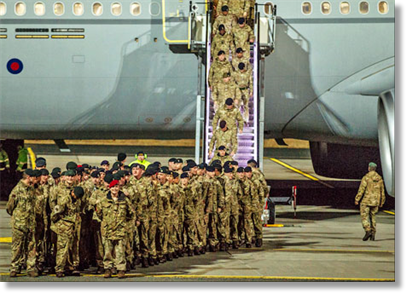
On a different note.......
I finally managed to re-live some of my past life last Friday evening when I visited Amari AB, here in Estonia, to meet the first UK contingent arriving for a new NATO mission that has been reported in the press recently.
In my capacity as the Deputy Commander, NATO Force Integration Unit, I was part of the official welcoming party but this did not prevent me from having a wander around the 'pan' to have a chat with the RAF movers, the crew of the Airbus 330 Voyager and even the ATLO Staff!
Thanks for all your efforts and I look forward to the next edition of the newsletter,
Cheers,
Mark
I finally managed to re-live some of my past life last Friday evening when I visited Amari AB, here in Estonia, to meet the first UK contingent arriving for a new NATO mission that has been reported in the press recently.
In my capacity as the Deputy Commander, NATO Force Integration Unit, I was part of the official welcoming party but this did not prevent me from having a wander around the 'pan' to have a chat with the RAF movers, the crew of the Airbus 330 Voyager and even the ATLO Staff!
Thanks for all your efforts and I look forward to the next edition of the newsletter,
Cheers,
Mark
Splashdown on the Equator!
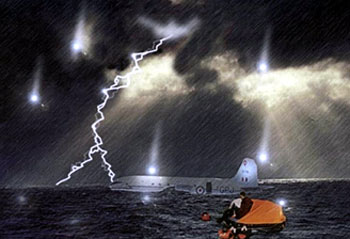
John Cooper was a passenger onboard Hastings TG579 that ditched into the Indian Ocean on March 1, 1960.
He and 19 other men spent 90 minutes in shark-infested waters waiting to be rescued after the plane went down in a storm on its approach to RAF Gan in the Maldives. They were eventually pulled to safety after being spotted by a Shackleton rescue plane.
"For 10 minutes after the crash it was just chaos," said John. "Everybody fought to save their own lives, and then helped to save the others. We were picked up by two launches that wouldn't normally go out in those conditions, but otherwise we would have been left to the elements and the sharks."
See John's epic tale of survival: http://ukmamsoba.org/spalshdown.htm
He and 19 other men spent 90 minutes in shark-infested waters waiting to be rescued after the plane went down in a storm on its approach to RAF Gan in the Maldives. They were eventually pulled to safety after being spotted by a Shackleton rescue plane.
"For 10 minutes after the crash it was just chaos," said John. "Everybody fought to save their own lives, and then helped to save the others. We were picked up by two launches that wouldn't normally go out in those conditions, but otherwise we would have been left to the elements and the sharks."
See John's epic tale of survival: http://ukmamsoba.org/spalshdown.htm
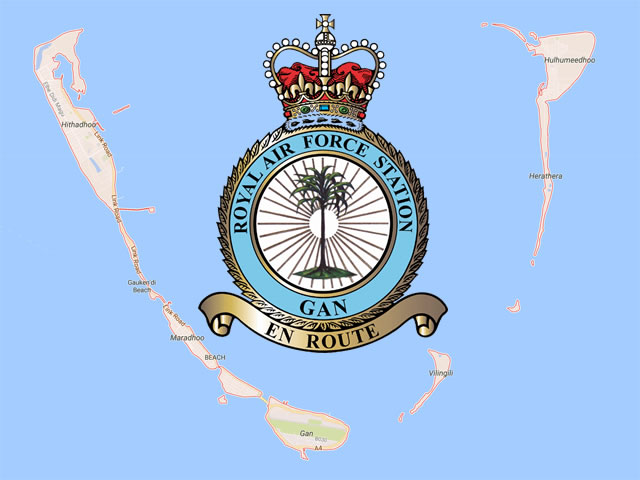
(Click on arrows to see the photo presentation)
Supply Run
For the first year (1957) the initial contingent of R.A.F. airfield construction workers were supplied and maintained with the essentials of life by the twice-weekly supply-run from R.A.F. China Bay in Sri Lanka which operated Sunderland flying boats from 205/209 Squadron R.A.F. as seen here moored at Gan.
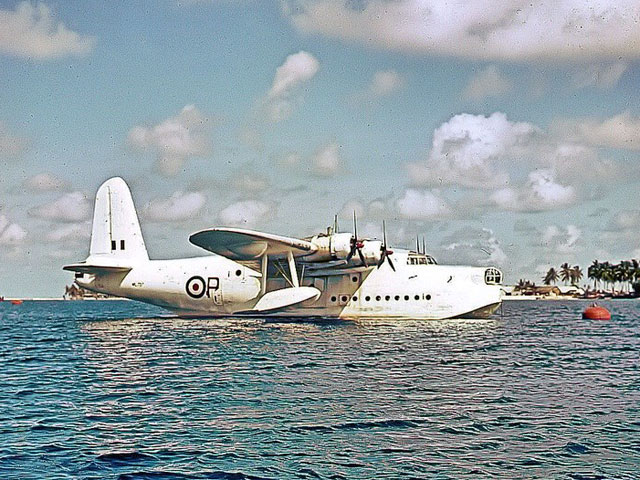
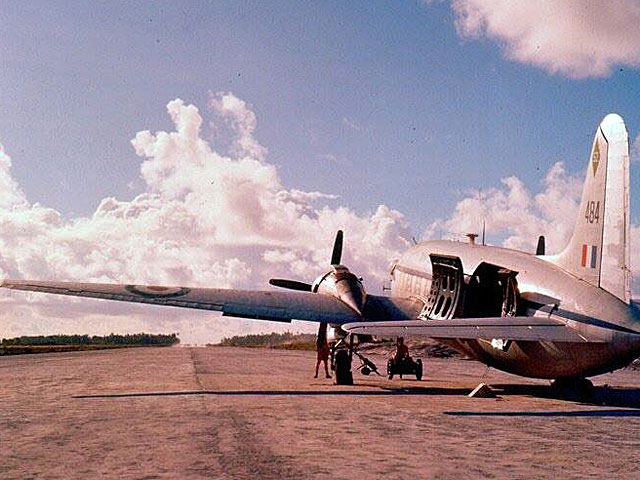
1958: The refurbished crushed coral runway was used until the new concrete runway had been built. A Vickers Valetta, the military version of the Vickers Viking civilian airliner was used on the Ceylon to Gan air-bridge. On arrival, aircraft were instructed to fly low along the runway to alert any workers working on or near the runway to remain clear until the aircraft had landed.
The Valetta could carry up to 36 passengers together with freight. The flying time from R.A.F. Katunayake near Colombo in Ceylon to Gan was about three hours forty-five minutes. The normal routine was for the flight to leave Katunayake early in the morning, arrive Gan around mid-morning, discharge passengers and freight, refuel, load-up and return to Katunayake the same day.
The Valetta could carry up to 36 passengers together with freight. The flying time from R.A.F. Katunayake near Colombo in Ceylon to Gan was about three hours forty-five minutes. The normal routine was for the flight to leave Katunayake early in the morning, arrive Gan around mid-morning, discharge passengers and freight, refuel, load-up and return to Katunayake the same day.
Crushed Coral Runway
February 1958: The Fuel Dump
Each barrel of aviation fuel held 44-gallons (200 litres) and had to be manhandled and transferred to a bowser to refuel arriving aircraft — 5,000 barrels x 200ltrs = 1 million litres!
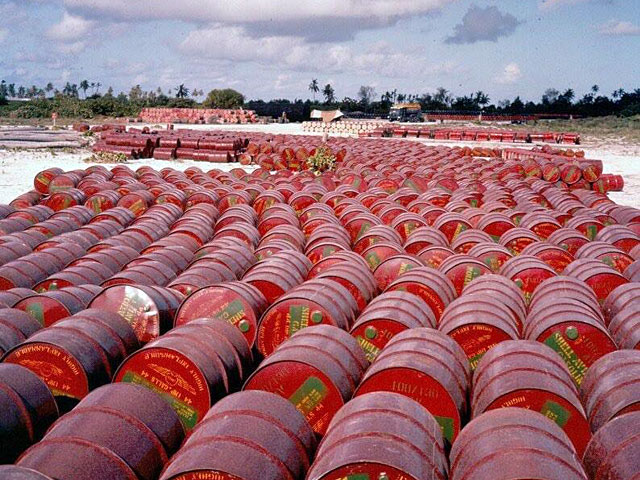
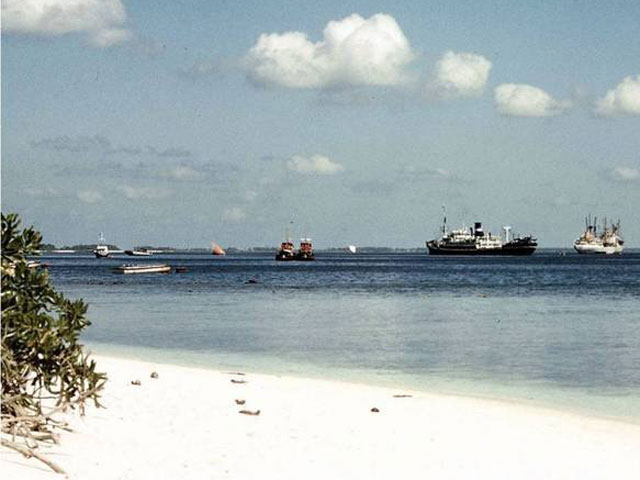
Supply Ships
Brocklebank Line, the Liverpool-based shipping company had the main contract to bring in supplies and cargo necessary to build a modern airfield.
This photo shows a Brocklebank vessel (left) and a Ben Line cargo ship (right) with cargo for Gan. Two newly arrived tugs can be seen tied-up to a buoy. From mid-1958 six lighters towed by these two tugs ferried most cargo ashore to the newly-built long jetty.
This photo shows a Brocklebank vessel (left) and a Ben Line cargo ship (right) with cargo for Gan. Two newly arrived tugs can be seen tied-up to a buoy. From mid-1958 six lighters towed by these two tugs ferried most cargo ashore to the newly-built long jetty.
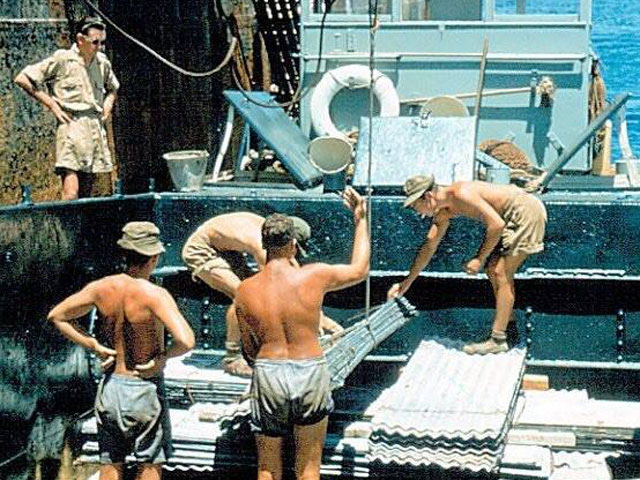
Landing Craft
The original RAF Marine Craft unit landing craft of the type used during the D-Day landings during WW2 were used for offloading smaller items of freight
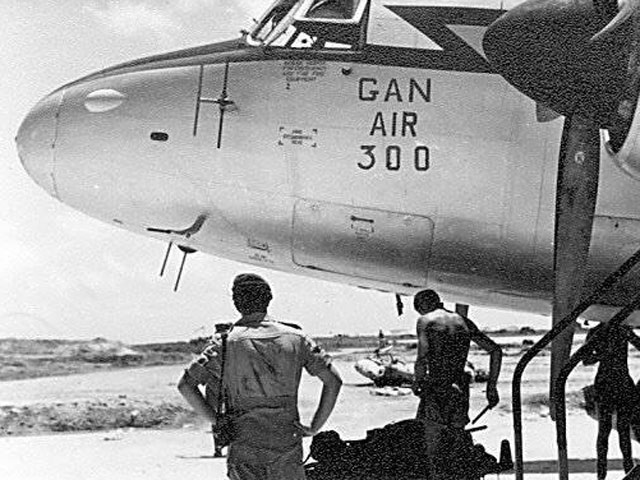
Defacing the Valettas
The aircraft servicing staff were in the habit of defacing the Valettas once they'd reached a significant milestone in the number of flights flown into the island. As seen here they commemorated the 300 flights
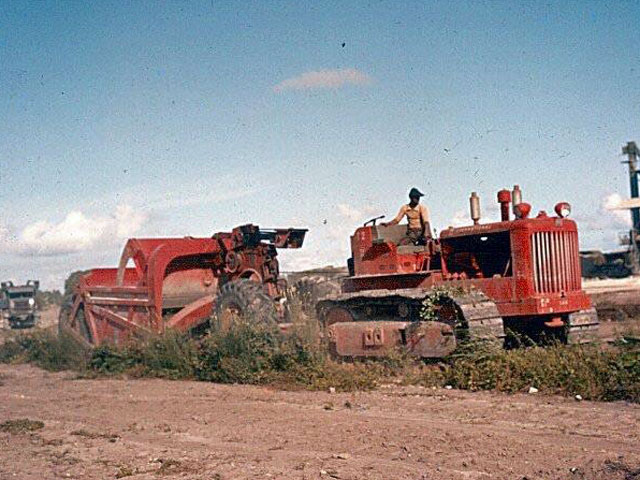
11,000 Trees Cleared
1959: RAF GAN, Addu Atoll. Bulldozers and Earthmovers cleared the trees and scrub from the island. In all 11,000 trees were cleared to make space for the new facilities.
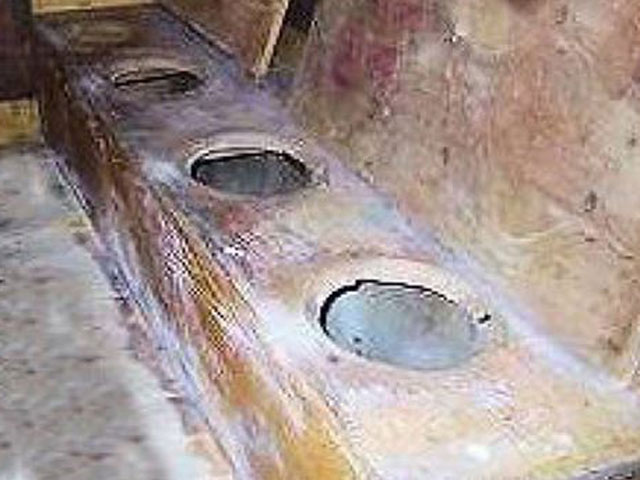
When you gotta go...
1957-58 “Thunderboxes” primitive toilet facilities available at Gan.
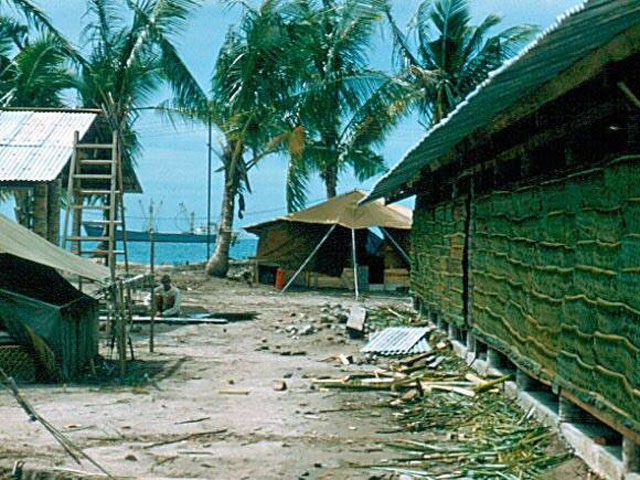
Accommodation Upgrades
1959: The living accommodation improved and basic Kadjan-walled blocks were built. They were simple and effective. Lay a concrete base with palm tree trunk uprights set into the concrete to support the corrugated iron roof. Fix joists and bearers across the uprights and fix woven kadjan palm leaves onto the bearers to hang down as walls. They were enormously hot during the day with the heat of the sun radiating off the bare corrugated iron roof (which made a terrible din when it rained), but it was luxury compared to living in a brown tent.
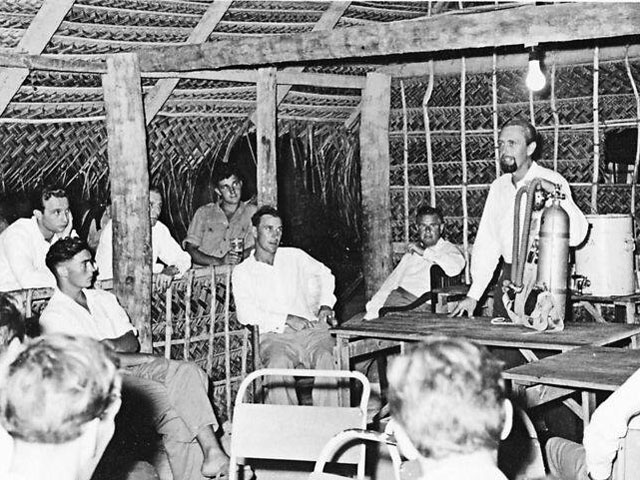
Celebrated Diver
Dr Hans Hass talking diving to an attentive RAF Gan audience. On Professor Hass’ immediate right is Mr Alex Smith (Air Ministry Works Department) and next to him Sqn Ldr Roy A Schofield, Commanding Officer RAF Gan 1957 to early 1958
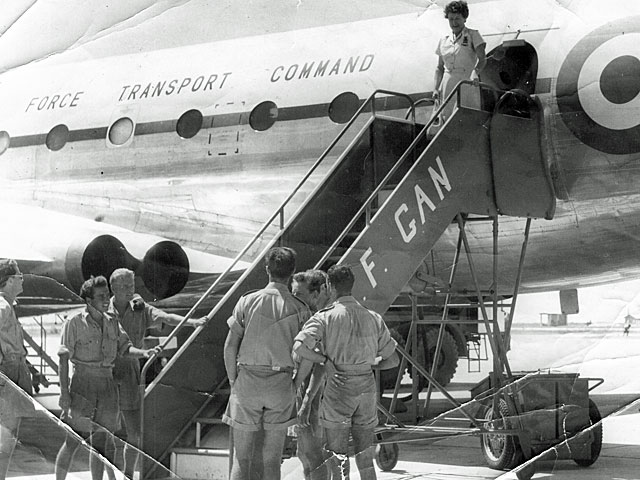
Gan's First Lady
4th October 1960 - The arrival of the very first WRVS (Women's Royal Voluntary Service) lady on Gan, Gwen Caton. She is stepping down from the RAF Transport Command Comet 2 to a welcoming committee of a few appreciative lads.
Vulcans on Gan
35 Sqn Vulcans on Gan during Exercise Spherical, April/May 1965
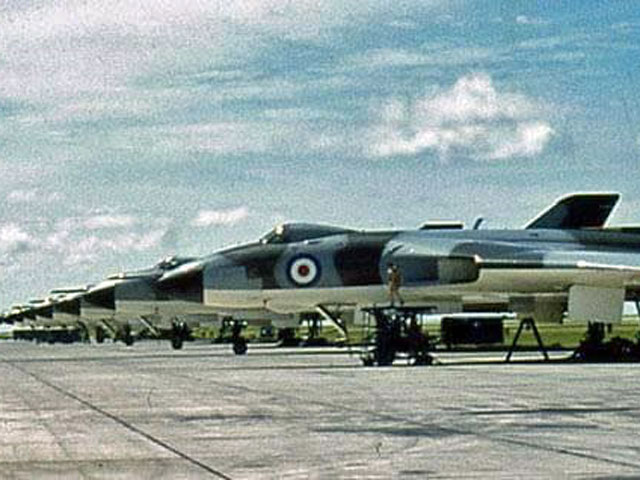
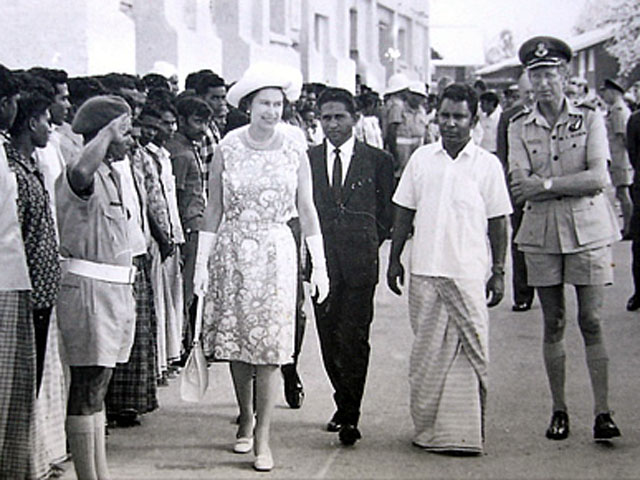
Royal Visit
Queen Elizabeth II visits the Maldive Islands in 1972
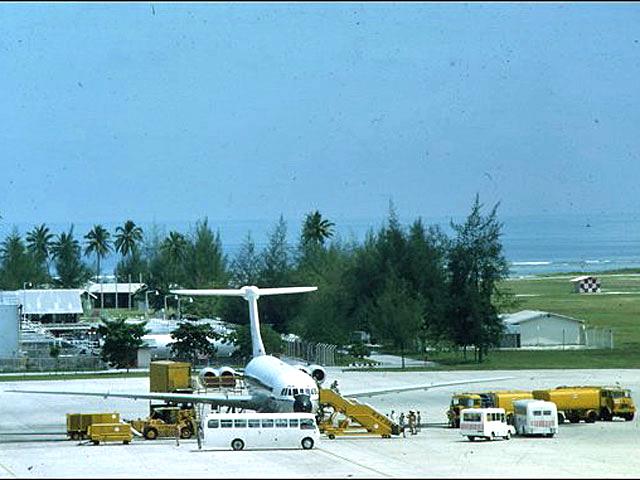
Fast Turnaround
The normal turnaround for a VC-10 on Gan was less than 50 minutes.
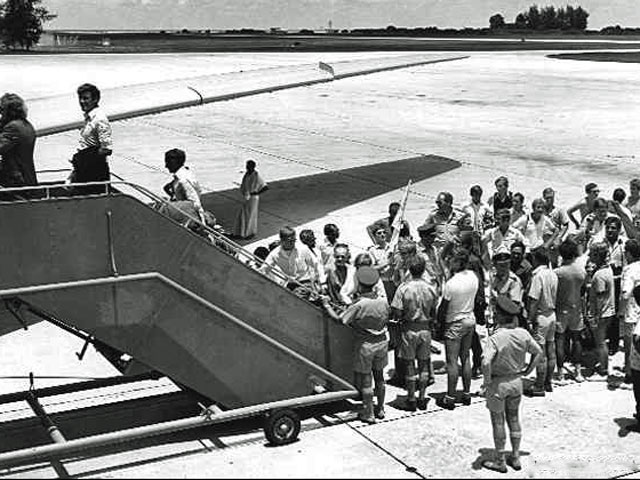
Saying Goodbye
Emotions were running high as a large gathering of ground crew say goodbye to the last passengers to transit Gan. March 28, 1976
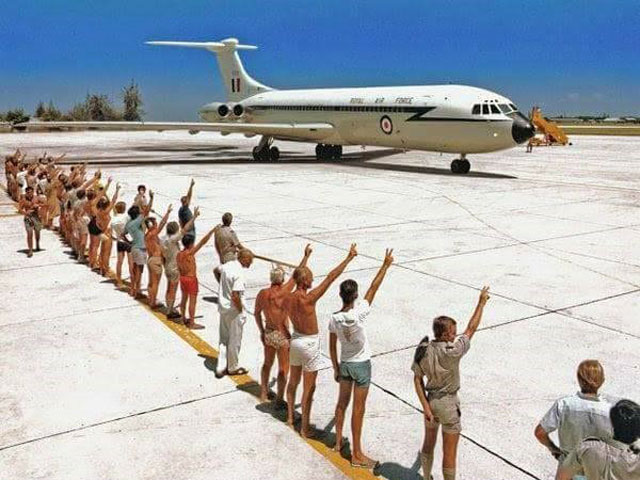
Last VC-10 to Transit Gan
28 March 1976 - The last VC-10 transitting through Gan from the Far East departs the island.
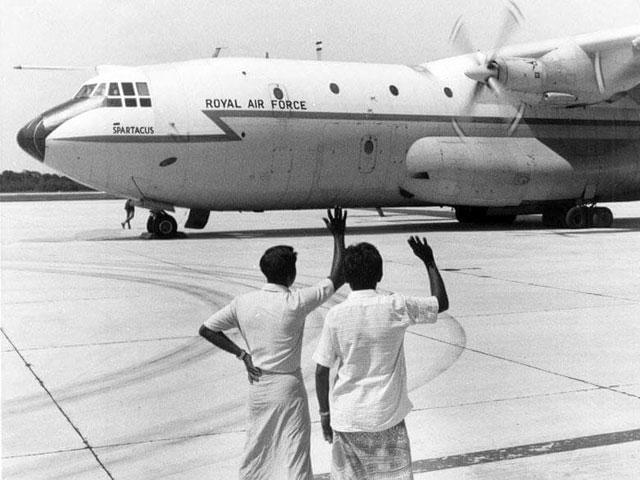
Last RAF Aircraft
31st March, 1976. The last RAF aircraft is starting engines prior to departing from Gan. The following day will see the RAF ensign lowered at the official handing over ceremony.
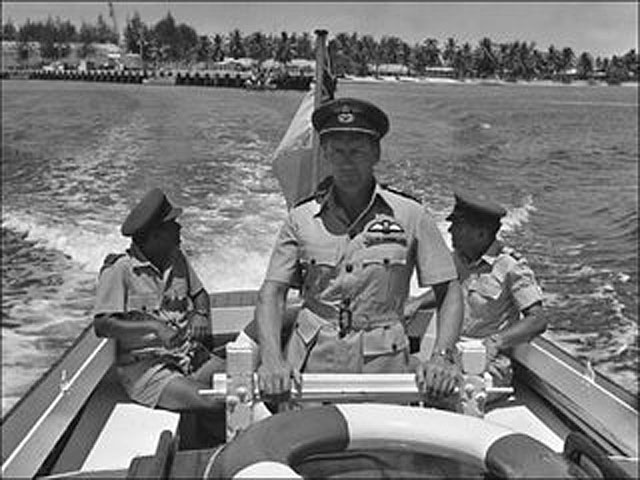
Bye-Bye Gan
1st April 1976, Gp Capt W. Edwards, the last Station Commander, departing RAF Gan for the last time accompanied by Sqn Ldr Carrera, OC 1153 MCU and FS Jack Brown
From: Keith Parker, Bowerhill, Wilts
Subject: UKMAMS and RAF Movements Association Tie
Hi Tony,
Please would you advertise the UKMAMS and RAF Movements Association ties in your next OBB, they are in the original syle with the "Swift to Move" logo on them, the delivered costs are as follows:
UK £12.85 / Europe £13.55 / Rest of World £14.55
Ties can be purchased through BACs To UKMAMS Association,
Sort Code 20-84-58, Acct No. 90981370
Then send an E-mail to Steve Beaumont, membership@ukmams.co.uk
CC: Keith Parker, keith-parker@blueyonder.co.uk
Please allow up to 28 days for delivery
Thanks, Keith
Subject: UKMAMS and RAF Movements Association Tie
Hi Tony,
Please would you advertise the UKMAMS and RAF Movements Association ties in your next OBB, they are in the original syle with the "Swift to Move" logo on them, the delivered costs are as follows:
UK £12.85 / Europe £13.55 / Rest of World £14.55
Ties can be purchased through BACs To UKMAMS Association,
Sort Code 20-84-58, Acct No. 90981370
Then send an E-mail to Steve Beaumont, membership@ukmams.co.uk
CC: Keith Parker, keith-parker@blueyonder.co.uk
Please allow up to 28 days for delivery
Thanks, Keith
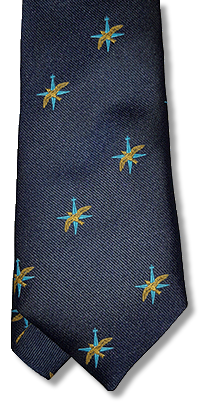
Twelve month 'no entry' tie - Don Hunter, 30700 St Maximin, France - "Fantastic!! David, many thanks indeed for your kindness. I shall wear it with pride and abstinence!"
Phantom print - Paul Gruner-Overgaard, Todmarton, Oxon, UK - "Received the print today and all good thank you. Just so that you know where it will be displayed here is a resume. Being an Ex Mover (now a Reservist) I currently work at RAF Brize Norton as a Ramp Agent for SERCO. A nice comfortable job with little stress. We have a shift of 13 ex RAF Techies with loads of plane spotters amongst them. They were getting very excited when I told them about the print that I had won. They were asking me loads of questions about it but me not being a spotter I could not answer all their questions. Any way, it will be framed and have a place of honour in my office along with other aircraft memorabilia. Thank you for your kindness and posting it to me. Its in a good home."
Phantom print - Paul Gruner-Overgaard, Todmarton, Oxon, UK - "Received the print today and all good thank you. Just so that you know where it will be displayed here is a resume. Being an Ex Mover (now a Reservist) I currently work at RAF Brize Norton as a Ramp Agent for SERCO. A nice comfortable job with little stress. We have a shift of 13 ex RAF Techies with loads of plane spotters amongst them. They were getting very excited when I told them about the print that I had won. They were asking me loads of questions about it but me not being a spotter I could not answer all their questions. Any way, it will be framed and have a place of honour in my office along with other aircraft memorabilia. Thank you for your kindness and posting it to me. Its in a good home."

Tornado print - Eddie Hewitt, Sheffield, UK - "Fantastic - that's brill Tony! Thank you so much to you and the generous benefactor David Stevens. The print will take pride of place in my office at home (where I work)."
UKMAMS original tie - David Powell, Princes Risborough, Bucks, UK - "Valuable goods arrived safely in the post today. Delighted to have once again a 'proper' RAF Abingdon MAMS tie. I was trying to remember who organised it? It was certainly a very limited purchase, and made at about the same time as the RAF Abingdon Officers Mess Magic Roundabout Appreciation Society Tie (similar blue but with a gold 'Dougal').
Thank you again for the tie initiative."
UKMAMS original tie - David Powell, Princes Risborough, Bucks, UK - "Valuable goods arrived safely in the post today. Delighted to have once again a 'proper' RAF Abingdon MAMS tie. I was trying to remember who organised it? It was certainly a very limited purchase, and made at about the same time as the RAF Abingdon Officers Mess Magic Roundabout Appreciation Society Tie (similar blue but with a gold 'Dougal').
Thank you again for the tie initiative."
Many thanks to David Stevens, without whom this contest would not have been possible.
This Newsletter is Dedicated
to the Memories of:
Brenda Slattery-Roberts (RCAF)
Peter Holland MBE (RAF)
Doug Sutton (RAAF)
Alfred Barr (RCAF)
to the Memories of:
Brenda Slattery-Roberts (RCAF)
Peter Holland MBE (RAF)
Doug Sutton (RAAF)
Alfred Barr (RCAF)
Tony Gale
ukmamsoba@gmail.com
ukmamsoba@gmail.com
The Maldive Islands sit some 600 miles south and west off the southern tip of Sri Lanka (formerly Ceylon). They are a long chain of coral islands. At the southern end sit Addu Atoll, Fedu, Maradu and Hitadu. I'm told at one stage during World War II some 250 ships, including the Queen Mary, were gathered there; doubtless an assault force, but where were they going? When I first saw the island in June 1958, it was littered with the detritus of war. The highest point on the island is about six feet above mean sea level and a walk around the whole place takes about twenty minutes. Dig a hole about three feet deep anywhere and there is crystal clear pure water.
I forgot how I got there - could it have been a Valetta? Did they have the range to fly Changi/Gan direct? Which squadron operated them; 48 or 52? We landed on the crushed coral strip, refeulled using the old Zwicky pump and then waved the aircraft off leaving a half-dozen of us to put our tents up close to the beach. I suspected that first night that we were too close to the water and awoke in the early hours to find the water lapping across the floor - I was wrong - it was an invasion of very curious king crabs! Creating a mess the following morning was easy. We hacked down a few palm trees and used the boles for a table and chairs. We persuaded the islanders to throw up an attap roof.
The tools which the islanders used were basic in the extreme. Take a drill made from vehicle spring steel, wrap a rope around it, take three men - one on the drill and one at each end of the rope and away you go! The beds they made for us were very much like the Indian charpoy except that they had the luxury of head and foot boards. The coconuts provided the coir for the rope stringing.
If memory serves there was most of a causeway at low tide between Gan and Fedu. We had at our disposal an old bomb scow and set off for Hitadu to visit the local chief accompanied all the way by navigating dolphins. (I have written elsewhere about the dusky maidens we encountered.) This was a formal visit to talk about the possibility of providing the chief with an elderly Air/Sea Rescue Launch to boost his mana and keep him on side. I came away with a gift, now a part of the family memorabilia, a sword stick. The wooden outer was made in halves along its length and the glued together. The ferrule, strengthening bands and the handle/body fittings were made from bayonet cap light bulb brass, as was the plate engraved 'Hitadu'. Once again the blade was vehicle spring steel and I have often wondered since how they worked the spring steel.
I forgot how I got there - could it have been a Valetta? Did they have the range to fly Changi/Gan direct? Which squadron operated them; 48 or 52? We landed on the crushed coral strip, refeulled using the old Zwicky pump and then waved the aircraft off leaving a half-dozen of us to put our tents up close to the beach. I suspected that first night that we were too close to the water and awoke in the early hours to find the water lapping across the floor - I was wrong - it was an invasion of very curious king crabs! Creating a mess the following morning was easy. We hacked down a few palm trees and used the boles for a table and chairs. We persuaded the islanders to throw up an attap roof.
The tools which the islanders used were basic in the extreme. Take a drill made from vehicle spring steel, wrap a rope around it, take three men - one on the drill and one at each end of the rope and away you go! The beds they made for us were very much like the Indian charpoy except that they had the luxury of head and foot boards. The coconuts provided the coir for the rope stringing.
If memory serves there was most of a causeway at low tide between Gan and Fedu. We had at our disposal an old bomb scow and set off for Hitadu to visit the local chief accompanied all the way by navigating dolphins. (I have written elsewhere about the dusky maidens we encountered.) This was a formal visit to talk about the possibility of providing the chief with an elderly Air/Sea Rescue Launch to boost his mana and keep him on side. I came away with a gift, now a part of the family memorabilia, a sword stick. The wooden outer was made in halves along its length and the glued together. The ferrule, strengthening bands and the handle/body fittings were made from bayonet cap light bulb brass, as was the plate engraved 'Hitadu'. Once again the blade was vehicle spring steel and I have often wondered since how they worked the spring steel.
Visiting the island were Hans and Lotte Haas, the 'Jacques Cousteau' of the day, who were studying tiger sharks. They had a theory that if you swam towards them underwater and shouted they would sheer off. I was later to test the theory but even today I am not convinced.
And then there was the destroyer. Part of the problem was resupplying the island with Avgas. The Royal Navy solution was to blast a hole in the reef, sail through it, then tip the 50 gallon drums overboard leaving the locals to swim them ashore. They thought it was a great game but quickly tired of the sport. The snag with the hole in the reef was that it allowed sharks into the lagoon as I found out to my horror the next time I went snorkelling. It took me three weeks to pluck up the courage to go in again!
I can't remember the name of the destroyer, but it was probably the last of the open bridge ships [HMS Caprice]. I do remember that the captain was Commander Jimmy Startin [known to many as 'Hard Over Harry' he was an archetypal hard driving destroyer C.O. with more than a touch of the pirate about him!]. His crew told me that he was the youngest commander in the Navy, and that his father was an Admiral.
One day he took us on a firing exercise off the capital, Male. The object of the exercise was to steam up and down offshore and do a live-fire shoot. I forget how many times we crossed the Equator that day but it was a fair few. The day was memorable for three things; a rapid "check!-check!-check!" when fire control managed to aim on a reciprocal at Male instead of out to sea, tonic cost tenpence and gin twopence (a rapid introduction to pinkers followed). The third was to go fishing with a live firing of Sea Slug which hurled a pattern of mortars over the bridge and into the sea ahead. Then steaming into the middle of the pattern while the sea boiled. At £600 a shot and with just one fish staggering to the surface it proved to be an expensive meal!
And then there was the destroyer. Part of the problem was resupplying the island with Avgas. The Royal Navy solution was to blast a hole in the reef, sail through it, then tip the 50 gallon drums overboard leaving the locals to swim them ashore. They thought it was a great game but quickly tired of the sport. The snag with the hole in the reef was that it allowed sharks into the lagoon as I found out to my horror the next time I went snorkelling. It took me three weeks to pluck up the courage to go in again!
I can't remember the name of the destroyer, but it was probably the last of the open bridge ships [HMS Caprice]. I do remember that the captain was Commander Jimmy Startin [known to many as 'Hard Over Harry' he was an archetypal hard driving destroyer C.O. with more than a touch of the pirate about him!]. His crew told me that he was the youngest commander in the Navy, and that his father was an Admiral.
One day he took us on a firing exercise off the capital, Male. The object of the exercise was to steam up and down offshore and do a live-fire shoot. I forget how many times we crossed the Equator that day but it was a fair few. The day was memorable for three things; a rapid "check!-check!-check!" when fire control managed to aim on a reciprocal at Male instead of out to sea, tonic cost tenpence and gin twopence (a rapid introduction to pinkers followed). The third was to go fishing with a live firing of Sea Slug which hurled a pattern of mortars over the bridge and into the sea ahead. Then steaming into the middle of the pattern while the sea boiled. At £600 a shot and with just one fish staggering to the surface it proved to be an expensive meal!








